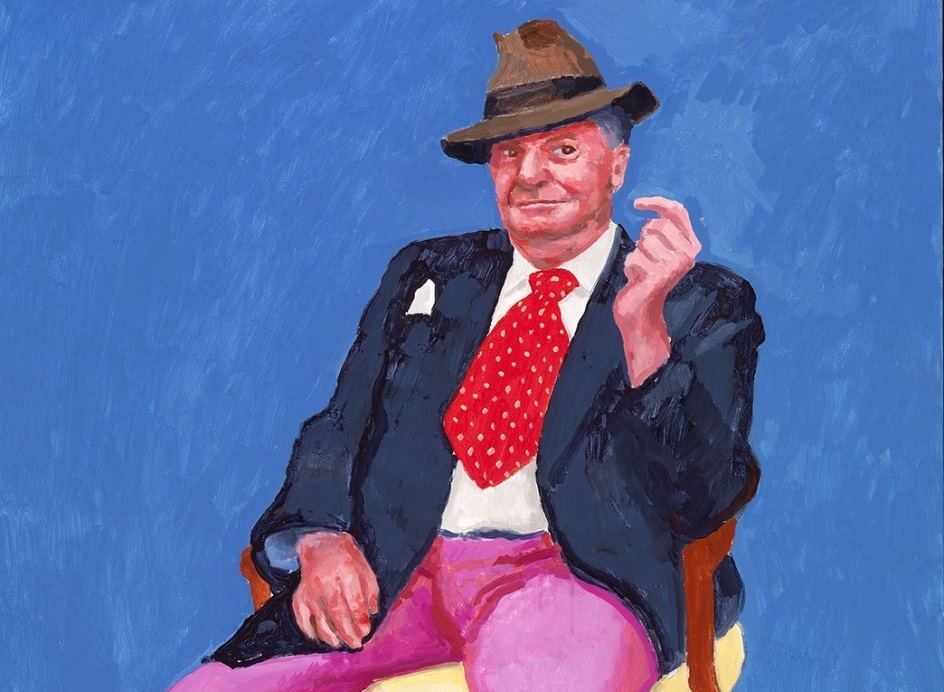- Details
- Written by Maira Herrero
I suspect that the idea of writing about French convent life in the early 18th century had occurred to the brilliant philosopher, writer and "Encyclopedie" founder and editor-in-chief Denis Diderot long before the spring of 1758 when the dismal news of a young nun's misfortunes reached and scandalised Madame d'Epirey's progressivist Parisian salon circle. Diderot had never forgotten his own beloved sister's sad fate within the confines of an Ursuline convent at Langres, where she'd been secluded her whole life due to delicate mental health. The story of Marguerite Delamarre, the nun whose woes began at the age of three when her parents sent her to a convent where she would remain until her death, despite tireless and desperate efforts to escape a life of privation and sacrifice there.
|
Author: Maira Herrero, |
 |
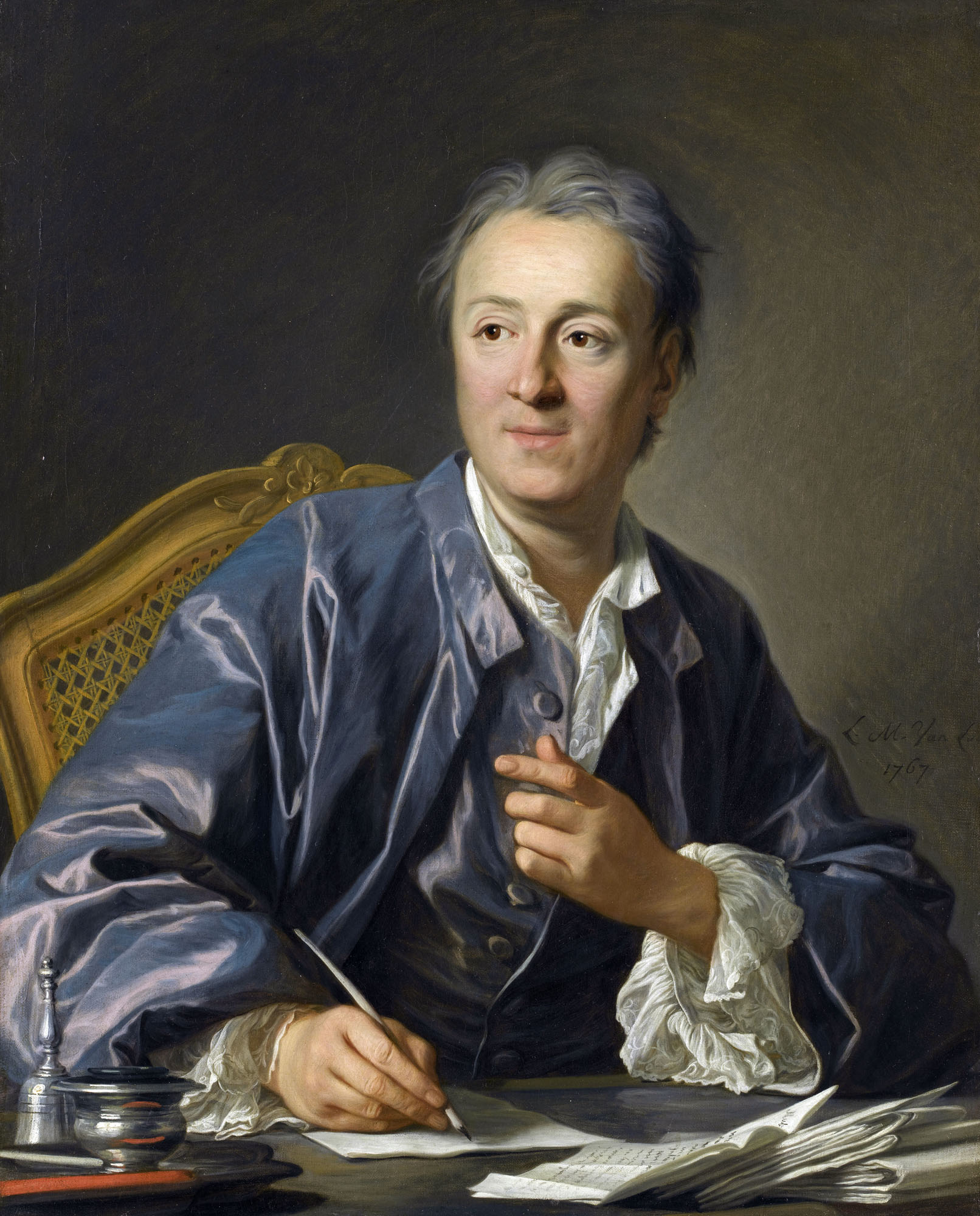
I suspect that the idea of writing about French convent life in the early 18th century had occurred to the brilliant philosopher, writer and "Encyclopedie" founder and editor-in-chief Denis Diderot long before the spring of 1758 when the dismal news of a young nun's misfortunes reached and scandalised Madame d'Epirey's progressivist Parisian salon circle. Diderot had never forgotten his own beloved sister's sad fate within the confines of an Ursuline convent at Langres, where she'd been secluded her whole life due to delicate mental health.
The story of Marguerite Delamarre, the nun whose woes began at the age of three when her parents sent her to a convent where she would remain until her death, despite tireless and desperate efforts to escape a life of privation and sacrifice there. Her desperation led her to seek help down every ecclesiastical and civil avenue within her reach but all her efforts came to nothing and she died without ever savouring the liberation she so desperately craved. The news had such a spiritual impact on a free-thinker friend of Diderot's, the marquis of Croismare, that he tried his utmost to help the impoverished nun with his time and money, albeit, again, to no avail. This incident, coupled with his deep-seated uneasiness about the then-customary practice of locking away young women lacking wealth or good looks behind convent bars, became the perfect excuse for him to write this unusual novel: "I write on the spur of the moment. I put pen to paper on The Nun and at three in the middle of the night, I was still writing. It's no longer a letter, it's a novel. It will contain truths, pathetic truths." This is how Diderot described the initial stages of his book, written in a direct style, almost report-like but without losing its dramatic powerand conferring on the work a mark of authenticity that reveals the terrible background to a reality only just coming to light.
The Nun is an authentic treatise on 'woman' wherein Diderot looks deeply into certain problems of our human existence, the ones that continue to plague us despite the world having changed radically. France, the most intellectually and culturally developed country in the second half of the 18th century, continued for a long time to uphold the moral dictates of the Ancien Regime. The established social order would take a long time to adopt the premises of the Enlightenment. The Nun is a story in epistolic form, written in the first person by its protagonist Suzanne Simonin, a beautiful and intelligent young woman who finds herself deprived, against her will, of the life she had been destined for. Suzanne's voice denounces issues as universal as the role of women in society, the hidden goings-on in convents and religious orders, the shame and blame fanaticism of the Church and the cynicism of an intolerant society of the day.
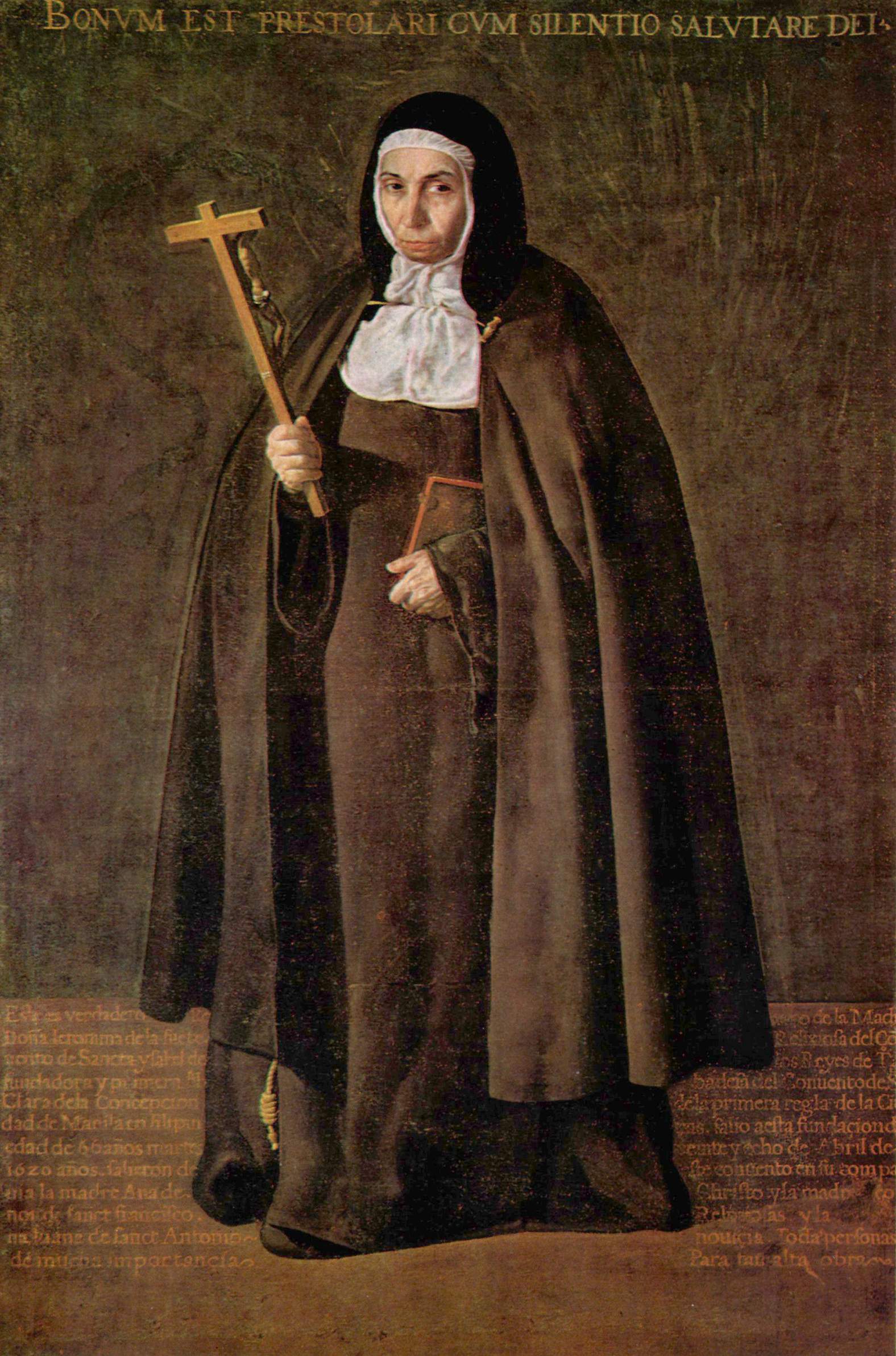
The crux of the novel's question is in the protagonism of 'woman' and her quest for independance by means of the idea of having self-defined, free thought and the liberty to exercise it. Being faithful to oneself, not taking on others' blame, not taking God's name in vain are just a few of the reflective themes of this novel. Basic moral dilemmas that are still pertinent in our modern society and which serve Diderot's purpose of converting one individual's lived experience into the central analysis of everyone else's in the world at large.
We are not here confronting the existence, or not, of an authentic God. Neither are we doubting faith in itself. Rather, we are denouncing a religion that denies what is the most precious thing for wo/mankind: namely, liberty. Diderot's anti-clericalism here references the stifling of free choice and the imposition of, under the auspices of God's will, an enforced, cruel and sordid existence, with its inevitable consequences. The novel is quite the treatise on female behaviour in the face of arbitrarily and definitively imposed obligations by a society that sought to control and desexualize them. It is also a cry for tolerance. Enforced vocational holy orders, lives devoid of dignity, work with no apparent point to it: all are in the mix here along with fanaticism, melancholy, hysteria, sexuality, reclusion and the dogmatic cruelty of a dark, out-of-control world warning of eternal damnation. All of which were and are alien to individual values and reason, as espoused by Enlightenment advocates.
From 1780 onwards, the novel appeared in instalment form in Grimm's Literary Correspondence, a handwritten newspaper-like publication accessible only to a small group of European aristocrats. It would not be printed for a public readership until 1796, more than 10 years after Diderot's death and too late for the author to mount a defence against the heated controversy it caused.
It is worth not forgetting that Denis Diderot was one of the figures who did most to radically change the mentality of the civilised world. As one of the great and universal Enlightenment pioneers, he elaborated his interest in anything and everything with great wisdom and originality. His thinking has stood the test of time against the great challenges of modern history with exquisite and exceptional prose writing and he continues to be a guide to understanding the vagaries of life and and our own involvement in them. One doesn't have to 'read between the lines' to realise the ongoing pertinence and sense of this work since Denis Diderot first started writing it over 250 years ago.
The Nun by Denis Diderot, published in English by Oxford University Press, Penguin Classics and Folio Society
(Translated from the Spanish by Shauna Devlin)
- Details
- Written by Marina Valcárcel
The three Royal Academy rooms dedicated to 82 portraits and one still life painted over the last two and a half years by an almost 80-year-old David Hockney, are heavy with the sensation one experiences in Tube stations at rush hour: a hum of murmurs, a mass of human bodies and, above all, a buzz of vital energy. Three narrow rooms without natural light or fresh air but with an all too conspicuous barrel-vaulted ceiling that, if one's mind were to wander down to the far end of the last room, create a peculiar dialogue between the public and the characters Hockney introduces us to. A kind of living theatre. Full-body portraits, hung or rather squeezed tightly next to each other, half a metre from the floor, our eyes at the level of their lips.
|
Author: Marina Valcárcel
Art Historian
|
 |
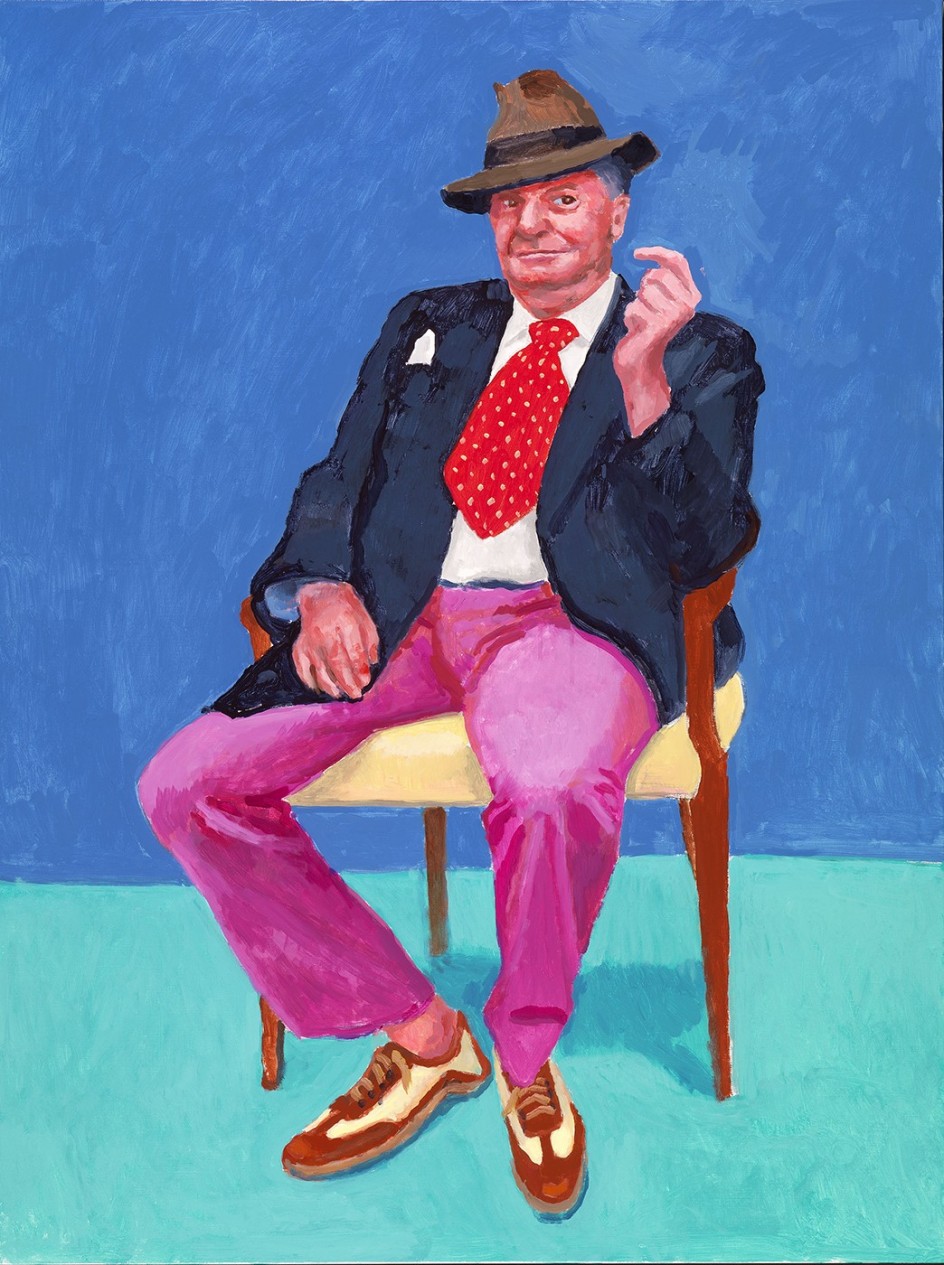
David Hockney ~ Barry Humphries (March 2015)
The three Royal Academy rooms dedicated to 82 portraits and one still life painted over the last two and a half years by an almost 80-year-old David Hockney, are heavy with the sensation one experiences in Tube stations at rush hour: a hum of murmurs, a mass of human bodies and, above all, a buzz of vital energy. Three narrow rooms without natural light or fresh air but with an all too conspicuous barrel-vaulted ceiling that, if one's mind were to wander down to the far end of the last room, create a peculiar dialogue between the public and the characters Hockney introduces us to. A kind of living theatre.
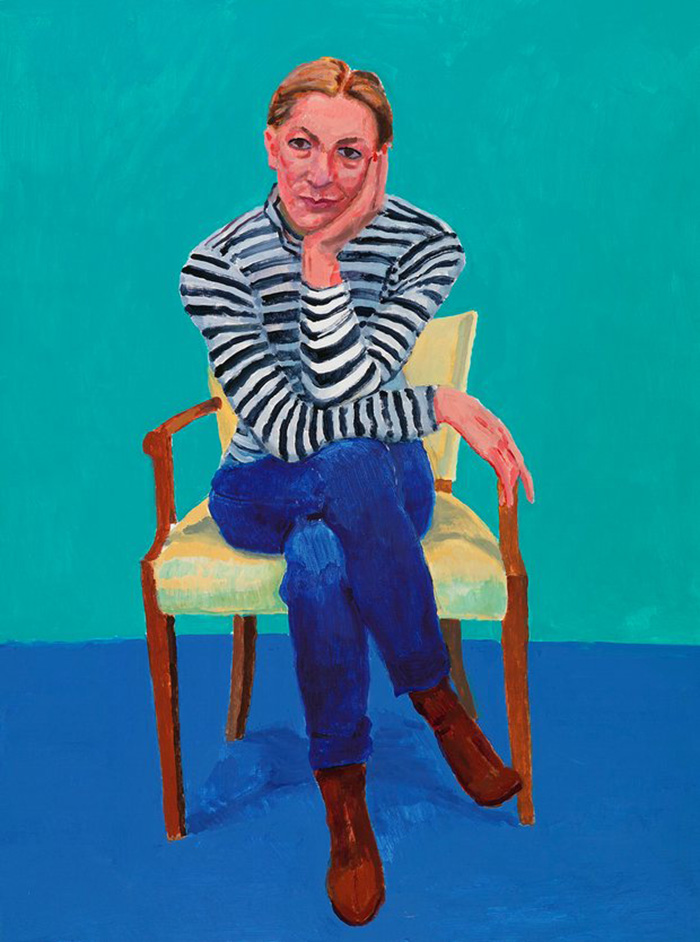
David Hockney ~ Edith Devaney (February 2016)
Full-body portraits, hung or rather squeezed tightly next to each other, half a metre from the floor, our eyes at the level of their lips. All of the paintings have the exact same 120 x 90 cm dimensions and the exact same pose time for the sitters of two and a half days or what he calls, using photographic terms, "a 20 hour exposure". And the coordinates are identical. All of the models sit in the same chair, on the same platform, with a blue curtain behind. The only differences are their posture and clothes. Variations on the same theme. The background and the floor are each a block of pure colour, either green of turquoise, with no apparent criteria as to which or why. And the faces, of an otherworldly pink and purple, seem about to explode from the subjects' dangerously high blood pressure! All are from a continent where the light is different. The white light of California. Seen from a certain distance, these gleaming paintings look as if they might have been painted on a plasma screen. Art sometimes emits that light.
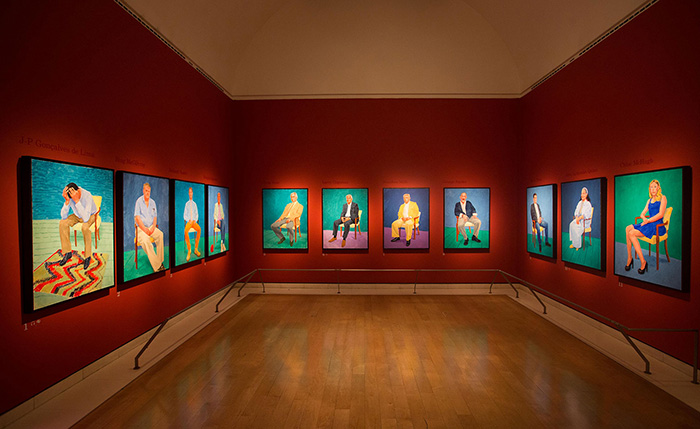
Exhibition Room : "82 Portraits and A Still Life" at the Royal Academy of Arts, London
In the spring of 2013, and for the first time in his life, David Hockney (Bradford, 1937) stops painting. It is a time of silence, also, and it lasts for months. Amongst his small, family-like team, no-one is finding it easy to get over the suicide of one of their number, Dominic Elliott, who died after consuming a bottle of bleach during a cocaine and ecstasy binge. Hockney decides to leave England for his house in Los Angeles and it is here, on 13th July 2013, that he paints his faithful assistant, Jean Pierre Gonçalves de Lima (J-P). Against a background and carpet of the saturated, cheery colours that are his trademark, stands a portrait that, nevertheless, portrays the fragility of life and a very deep sorrow. It is, perhaps, a self-portrait by the artist of his own mood and mental state. Sitting on a chair, his feet apart, J-P cradles his head in his hands, elbows on knees, in such a way that we cannot see his face. We imagine he is crying. Consciously or not, Hockney has called to mind Van Gogh's "Sorrowing Old Man", that sad little old man in the same pose, inside the four walls of a wooden cabin, the warmth from his open fire not enough to even take the edge off the cold.
Just the beginning
The portrait of J-P, with a powerful impact all of its own, could have been the only one, isolated in its message. But Hockney's responses are never to be expected and more paintings in the same vein follow. He embarks on a new project. He shifts from the enormous Yorkshire landscapes of his 2012 exhibition, "A Bigger Picture", towards the more intimate. This is the indefatigable Hockney we know. In the era of the selfie, Instagram or photos stolen from real life via tablets and mobiles, the most important painter alive today stops what he was doing to vindicate the two types of painting either neglected or given the kiss of death by Abstract Art at the start of the 20th century: the still life, here a table/fruit composition improvised by Hockney one day his model failed to turn up to an appointment; but especially, the portrait.
In this new series, all his subjects are friends, relatives or collaborators and nothing is commissioned, stand-alone, or meant to be dispersed, sold or given away. They are components of a unique artistic declaration, a profession of faith not just in the portrait but in painting itself. And above and beyond any sociological aspect is the analysis of human psychology embedded in these 82 portraits.
Hockney's taste in literature would tend towards the 'heavy'. At this time, he is immersed in his reading of Balzac's Human Comedy. The sequence of portraits he has in mind becomes a visual study in humanity on a par with Balzac's literary endeavours. Hockney could never be classed as a reader of 'light' books: "Reading for me is not a leisure activity. Or a way to kill time while the world passes you by. I need a project. Something that pushes me to go on. And right now, these portraits are my engine".
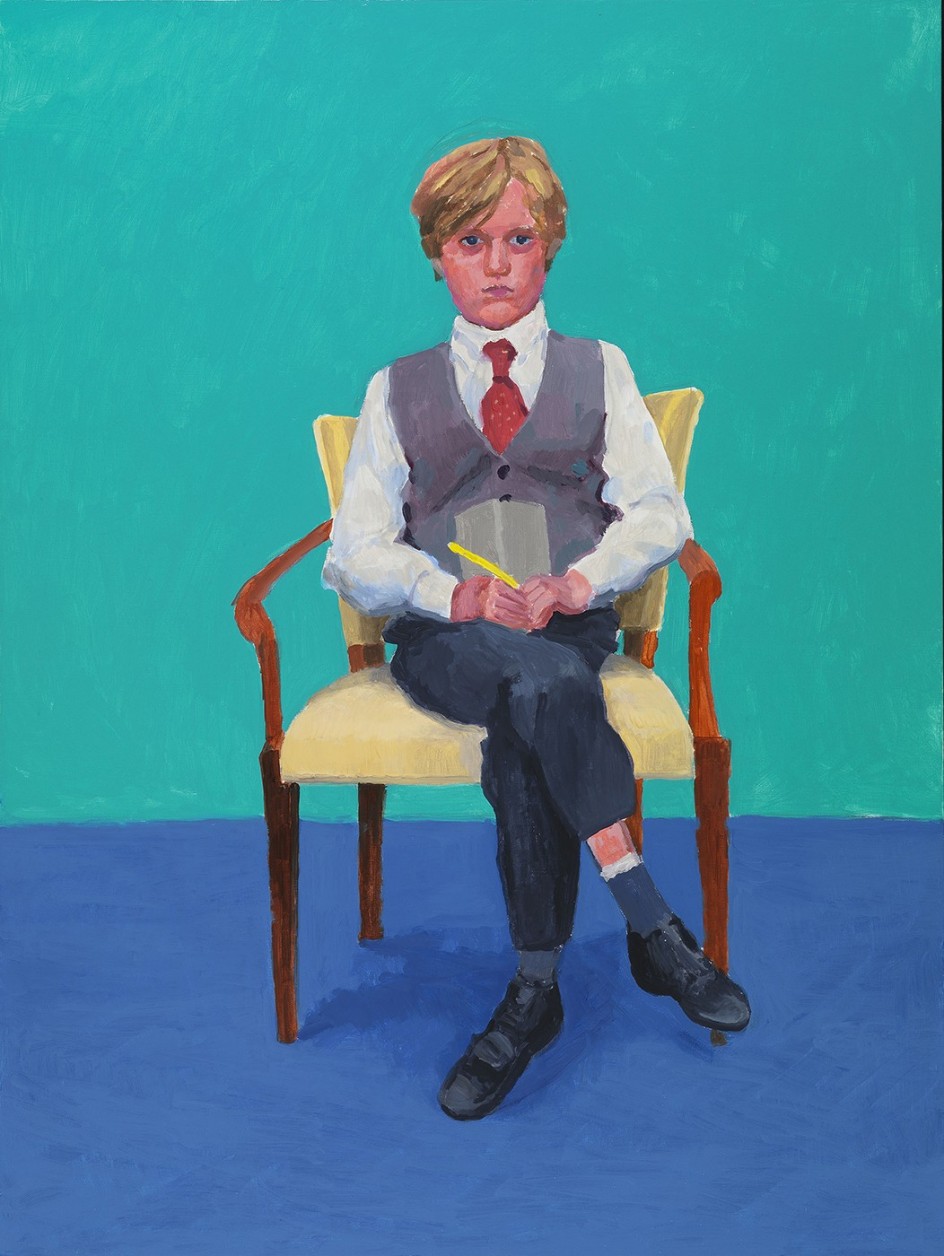
David Hockney ~ Rufus Hale (November 2015)
A need to paint
Hockney believes that human beings have an urgent need or pressing desire to paint, from childhood onwards. Painting comes from somewhere deep down within our roots, as do are feelings. He painted because he was fascinated by the world around him. And he still is. His eyes take in open landscapes, water, an impenetrable forest, the people he meets, plants, ..... but his real challenge is being able to translate that and reflect all he sees into the right combination of lines, dots and washes of colour. How can one relay onto canvas a visual experience, for instance a sunrise that encapsulates fleeting time, volume, air, water evaporating or light flickering? How does one capture and compress all of this onto a flat surface? Some time ago, he described this immersion into the creative process thus: "Being able to reduce things down to a line is no easy task". As well as being prodigiously accomplished at drawing, Hockney's thinking and composition come very much from a chromatic angle. He is a huge admirer of Piero de la Francesca and Fra Angelico. Aged 11, he stopped spellbound at a reproduction of The Annunciation by 'the painter of angels' on a corridor wall at his Bradford school. This is not an irrelevant anecdote. There is much of the 15th century Florentine painters in the English Hockney: clear, intense, fresco-like colours; the use of light; even his technique of alternating between acrylic, oil and watercolour which would suggest a quest for effects similar to the clarity afforded by tempera. For this series, Hockney used a new brand of acrylic paints, discovered by J-P, that he thought especially useful: the advantages of watercolour - speed, spontaneity and transparency;combined with those of oil - layer upon layer of paint, allowing him to return to different areas of the canvas as often as was necessary.
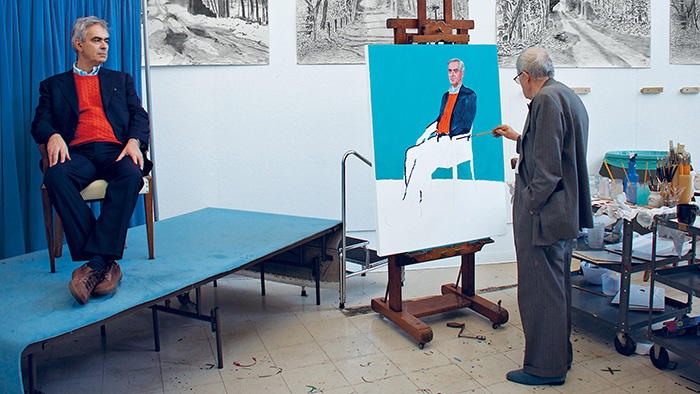
Non-verbal language
"Hockney has an inner strength that gives him the impetus to paint" says JP whilst filming a new portrait session. After just 30 minutes of carbon drawing directly onto the canvas there emerge the outlines of the facial features of Rufus, son of Tacita Dean and the only child portrait in the exhibition. Hockney has been almost deaf for a few years now and avoids crowded places but remains a tireless conversationalist. A contagious on, even. His hearing difficulties mean that he scrutinises the models' gestures, expressions and body language meticulously. For this reason, he prefers absolute silence while he works, albeit punctuated with the odd: "Pass me some cadmium yellow ... Give me a neutral grey, please". The colours are mixed in a couple of metal paletteson a trolley behind the easel. That same afternoon, Rufus will return to the platform. Hockney willl have positioned himself , at eye level with the boy, as with all his models, in order not to see their faces from below which would obscure their eyes. Next come the hands, which are make-or-break for Hockney: "I think the skin of the hands gives us the skin of the face. If you get the hands right, the face will always follow". At a certain point, he will step away from the easel to rub the boy's suede shoes, as if to analyse their texture. He will be thinking about the shadow they cast on the rug. And then Hockney will return to his abstracted silence and his erudite travels through the History Of Art to the Orient where shadows don't exist and a painting's tale is told via various points of light. And then he'll return to Rufus Dean's feet. Wasn't it he who said: "A shadow is just the absence of light"?
(Translated from the Spanish by Shauna Devlin)
David Hockney: "82 Portraits and 1 Still-life" at the Royal Academy of Arts, Burlington House, Piccadilly, London
Curator: Edith Devaney
2nd July ~ 2nd October 2016
- La comedia humana segun David Hockney - - Página principal: Alejandra de Argos -
- Details
- Written by Elena Cué
Adriana Varejão (Brazil, 1964) articulates the arts: painting, sculpture, photography or architecture with a contemporary baroque style. Beneath a complex conceptual process lie principles such as identity, assimilation, anthropology, the body… stemming from her deep-rooted historical and cultural heritage. The three centuries of Portuguese colonization are reflected in her works by way of mosaic tiles, water or flesh, with references made to the primitive history and the indigenous identity of her country; as well as in the excess, the monumentality, the dramatic esthetics displayed in her penchant for the baroque. An art full of symbolism, of the bends and folds so typical of the esthetics of the period. At the same time, bodies that are objectified and then desecrated. Destruction and annihilation in the colonization process, but also assimilation and the creation of new values, in step with nature.
Author: Elena Cué
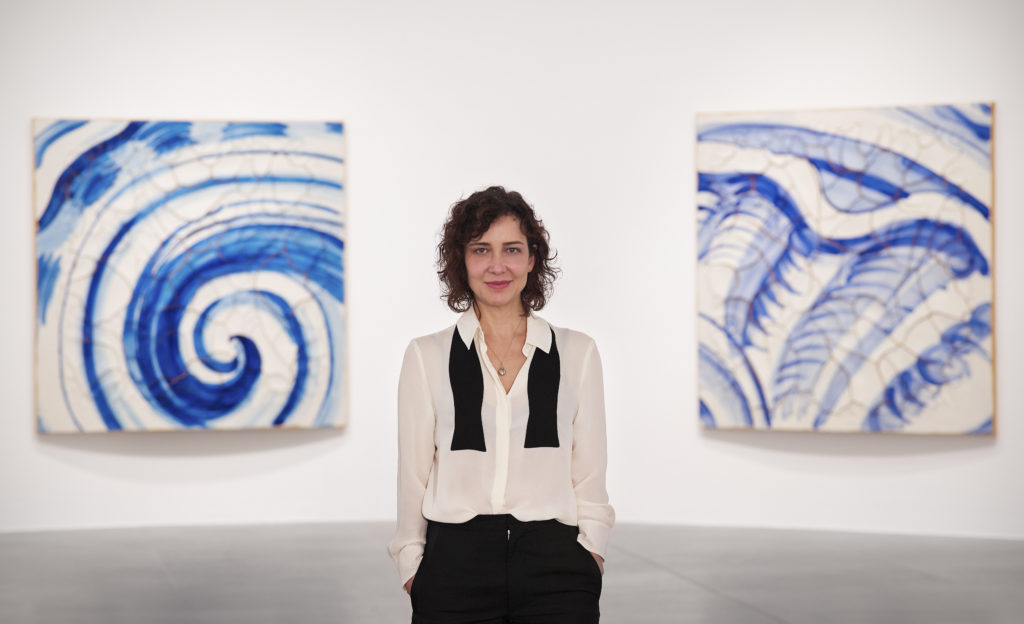
Portrait of Adriana Varejão. Photo by: Matteo D’Eletto M3 Studio © Gagosian and the artist.
Adriana Varejão (Brazil, 1964) articulates the arts: painting, sculpture, photography or architecture with a contemporary baroque style. Beneath a complex conceptual process lie principles such as identity, assimilation, anthropology, the body… stemming from her deep-rooted historical and cultural heritage. The three centuries of Portuguese colonization are reflected in her works by way of mosaic tiles, water or flesh, with references made to the primitive history and the indigenous identity of her country; as well as in the excess, the monumentality, the dramatic esthetics displayed in her penchant for the baroque. An art full of symbolism, of the bends and folds so typical of the esthetics of the period. At the same time, bodies that are objectified and then desecrated. Destruction and annihilation in the colonization process, but also assimilation and the creation of new values, in step with nature. Sensuality and eroticism emerge as a clear oriental allusion to round off the work of this artist.
She has just opened, for the first time in Rome, two large exhibits: the first, Adriana Varejão: Azulejão in the Gagosian Gallery, and the second, Transbarroco in the Villa Medici. These have been the initial focus point of our conversation on the sources of her artistic inspiration.
What authors have enriched your thought and your work?
The Cuban writer Severo Sarduy has been very influential on my work, because he thought about the Baroque from a very dense perspective. There are two books that were important Written on the Body and The Baroque. As a Cuban, his perspective was distinct from the Europeans. Together with Jose Lezama Lima and Octavio Paz, his writing was very important in the beginning to help me build my intellectual framework. A bit later, in the nineties, I read the historian Sergio Buarque de Hollanda's book Visions of Paradise, and Gilberto Freyre's Casa Grande Senzala. With these two books, my perspective on history began to form in my work. In recent years, I have been working actively with the work of contemporary historians such as Carlo Ginzburg and Giovanni Levi and in Brasil with Lilia Moritz Schwartz, Antonio Risério, and anthropology Eduardo Viveiros de Castro.
Continuing with the Brazilian society, What do you think of the current artistic scenography in Brazil?
I think that Brazil is a failed project as a country, socially, politically and economically. But in terms of its cultural identity, it is very potent because of the huge richness and variety of languages that is the result of miscegenation. It has so much to show to the rest of the world.
When did you realize you would like to be an artist? And, how was this process?
Decisions in life do not happen just like that. Every child begins by making art and experimenting. As they grow, some people then lose the ability and conform to other expectations. Let's just say that I became involved, inextricably, and it is a process of constant renewal, up until today.
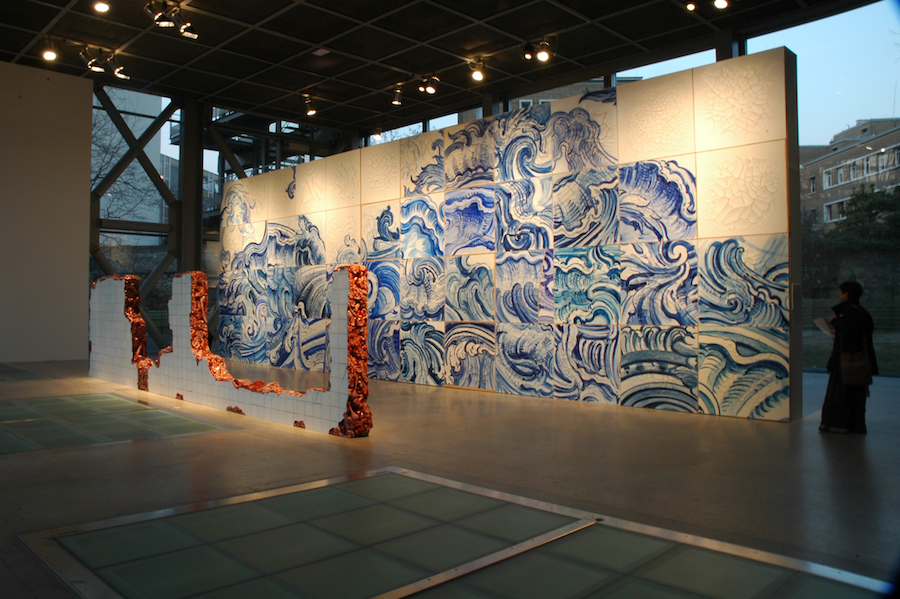
Installation view, Fondation Cartier, Paris. © Adriana Varejão. Photo by Vicente de Mello. Courtesy Gagosian Gallery.
In your series Tongue and incisions (walls with incisions through which entrails sprout out), the inorganic matter of the tiles is joined together with the organic matter of the viscera. Where does this need come from?
I wanted to combine the rational grid of the tiles with the erotic nature of meat, all simulated within the artificial and voluptuous language of the Baroque. The tiles are not tiles and the meat is not meat.
You convert the object into something transcendental when you add entrails, our most inner and private parts, only to later tear it up. What enigma hides behind these pieces?
It's to reveal a body behind the layers. When I am dealing with "history", I am dealing with history imprinted or inscribed on bodies, private, fluid, and individual -- which is very different from the official versions of world history.
That meat is like a violent explosion. Does it comprise any sort of love or sacrifice?
Yes. I am engaged with the history of art not reality. Painting meat and flesh belongs to a very, very old tradition in painting -- pintura de bodegon and the Baroque tradition that exposes the body through wounds, and for which the bleeding anatomical heart is the emblem. Think of Goya, Rembrandt, Gericault, Soutine, Bacon, and then, of course, Paul Thek, who worked in three dimensions with his modernist "reliquaries."
There is an Eastern penchant that is reflected in references to the great Wave of Kanagawa, landscapes and eroticism... What sort of interest do you have in this culture?
I am dealing with parody, not with real history. And in doing so, I am addressing the migration of images, from Portugal to Brazil via Asia, which you can find, for example, in the interior decoration of Baroque churches in Brazil.
Related to the Azueljao paintings, I also studied Chinese Song pottery of the eleventh century. I became deeply fascinated by its characteristic surface cracks and its attendant philosophy. It is in these cracks that Chinese writing actually originates. An entire aesthetic evolved from reading meaning into cracks, slowly becoming its own culture.

Adriana Varejão, Panacea Phantastica, 2003 – 2008, at Inhotim, Brazil
Please tell me about your installation at Inhotim in Belo Horizonte, Brazil, where all of the arts come together as a total work.
Much of my work is inspired by the traditional Portuguese azulejo, which were traditionally used to decorate architecture. My Inhotim project is a modern architectural cube that is penetrated by water, terraces, staircases. I made a container with an inner skin of tile paintings, sculptures that relate to architecture, and real tiles incorporated into built-in architectural furniture.
Thermal baths, pools, tiles and water. Once again, we see the organic and the inorganic in your iconography. Sometimes there are ripples of violence in your portrayal of water. In your work, what is the meaning of the connection between violence and water?
It is only fiction; the inference of violence gives some drama to these scenes. In the sauna paintings, I deal with very classical topics of painting -- paint, color, tone, perspective, and so on. They also reflect the erotic literature that I was reading at the time -- Georges Bataille and the Marquis de Sade. I gave these paintings titles like The Collector, The Seducer, and so on. There is an ambiguous atmosphere, a suspended narrative in these paintings. When I was working on them it was much more about painting than telling stories.
Some of your works display the prevalence of violence, the violation of limits, both sexual and in the form of the abuse of the body, sacrifice and death. What is behind this tendency for such extreme life situations?
To elaborate on what I said earlier, art is an experimental universe where everything can be played at the edge. That is the role of art. I explore violence in many forms in art, not in life. Just as de Sade attacked language not the body itself, acting symbolically.
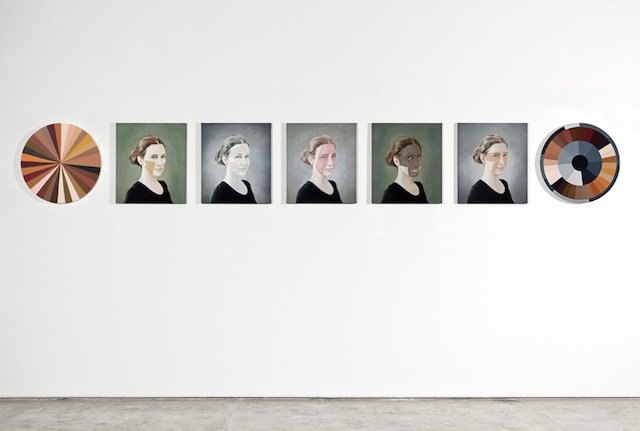
Adriana Varejão’s series Polvo. Image courtesy of ICA Boston
In your series Polvo –a set of self portraits-, the central focus actually resides in the changes in your skin colour. What message are you conveying about the racial and cultural identity of Brazil?
This is about the mestizo identity of Brazil, which is nothing to do with the polar opposites of black or white, but with all the many shades and subtleties and variations in between. Polvo is a paintbox where the names of the paints reveal that every definition is about language, like "Almost White." I started thinking about the idea of "flesh tone" and what it means in different cultures, but in the beginning I could only find a pink color in all of the oil-paint brands that I was collecting all over the world. So, I decide to develop a conceptual brand "Polvo", that reveals the complexity and variety of the subject. Color is a language subject.
And what is the relationship between identity and the portrayal of power and subjugation in your work?
I believe in miscegenation, not the dichotomy of master and slave. Brazil evolved as a country with a cultural (mestizo) identity that is so strong that it is impossible for any single identity to remain fixed, separate, and intact for more than one generation.
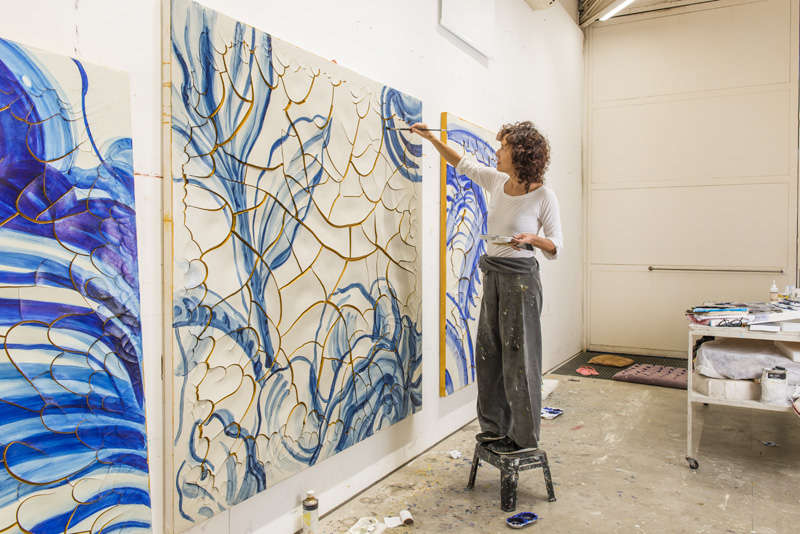
Portrait of © Adriana Varejão. Photo by Vicente de Mello. Courtesy Gagosian Gallery.
Adriana Varejão: “Azulejão” Until December 16, 2016
Gagosian Rome - Via Francesco Crispi 16, Rome
- Details
- Written by Kilian Lavernia
“I only survived thanks to art. It gave me faith in my own existence." And this is how bluntly Tracey Emin (Surrey, 1963) writes in her explosive autobiography Strangeland (Sceptre, 2005; Spanish translation published 2016), a collection of personal writings and reminiscences that allow us an insight into an undoubtedly complex persona. And this without falling into the trap of clichéd judgements on her provocativeness or exhibitionism, precisely because her personal history and her artistic identity are intertwined so fascinatingly and so irreverently. She has made what was once cutting-edge ~ the merging of intimacy, art and life to make something insoluble ~ into a new, confessional-style, conventional artform. For this reason, Emin's artistic output cannot be fully understood without reference to her life and this is not to state the obvious just for the sake of it.
“I only survived thanks to art. It gave me faith in my own existence." And this is how bluntly Tracey Emin (Surrey, 1963) writes in her explosive autobiography Strangeland (Sceptre, 2005; Spanish translation published 2016), a collection of personal writings and reminiscences that allow us an insight into an undoubtedly complex persona. And this without falling into the trap of clichéd judgements on her provocativeness or exhibitionism, precisely because her personal history and her artistic identity are intertwined so fascinatingly and so irreverently. She has made what was once cutting-edge ~ the merging of intimacy, art and life to make something insoluble ~ into a new, confessional-style, conventional artform.
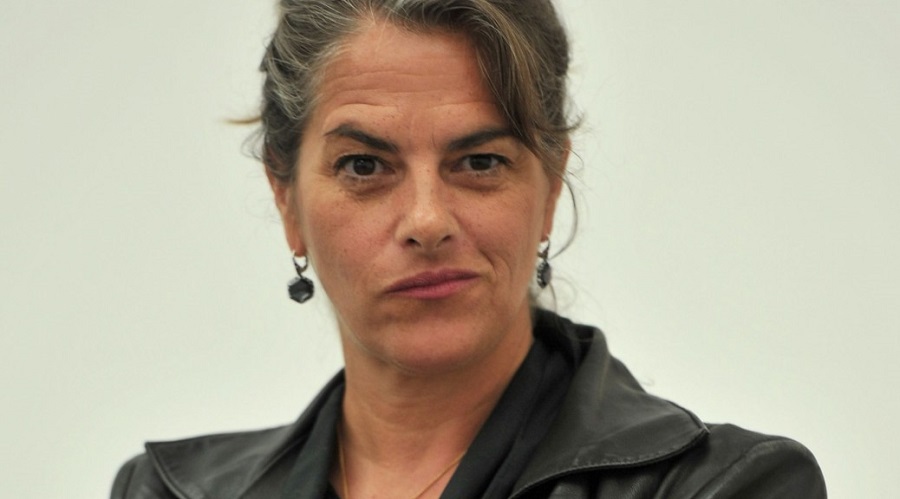
Tracey Emin in 2014 (Image available at www.highlandradio.com)
For this reason, Emin's artistic output cannot be fully understood without reference to her life and this is not to state the obvious just for the sake of it. With a painfully complicated childhood and adolescence (raped at thirteen, incest, abortions, anorexia, alcoholism, poverty, social rejection, …), the artist here reveals her recurring episodes of suffering, humiliation and trauma with brutal and unchecked frankness. She uses artistic creation to recreate her own memories. It's almost akin to therapy, aiding her recovery from certain periods in her life, all of which were marked by searing pain and resentment. Tracey Emin is a survivor of her own adolescent meltdown. Sex, drug abuse and hangovers were her environment while art was a private, stable place away from all of that. So the clarity with which she expresses herself in her memoirs is a visceral nudity of no little discomfort: “I'm alcoholic, neurotic, psychotic, a whinging loser obsessed with myself but I'm an artist."
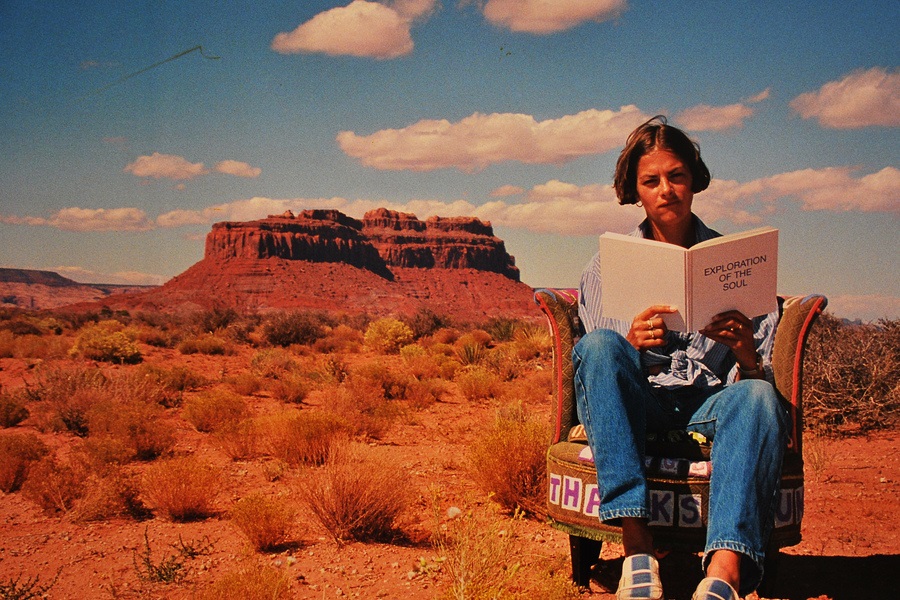
"Monument Valley" (1995-97) (Image available at proyectoidis.org/tracey-emin/)
Beyond the autobiographical rawness of Strangeland, however, her artistic consolidation over the last few years allows for a more integral, subtle stocktaking of her contribution to contemporary art history. Emin belongs to that tradition of artists initiated by Dadaists such as Duchamp, through the dreamy, autobiographical oneirism of Frida Kahlo, the darkest manifestations of expressionism by Egon Schiele and Edvard Munch or the pop art of Robert Rauschemberg and as recent as the conceptual exhibitionism of Sophie Calle.
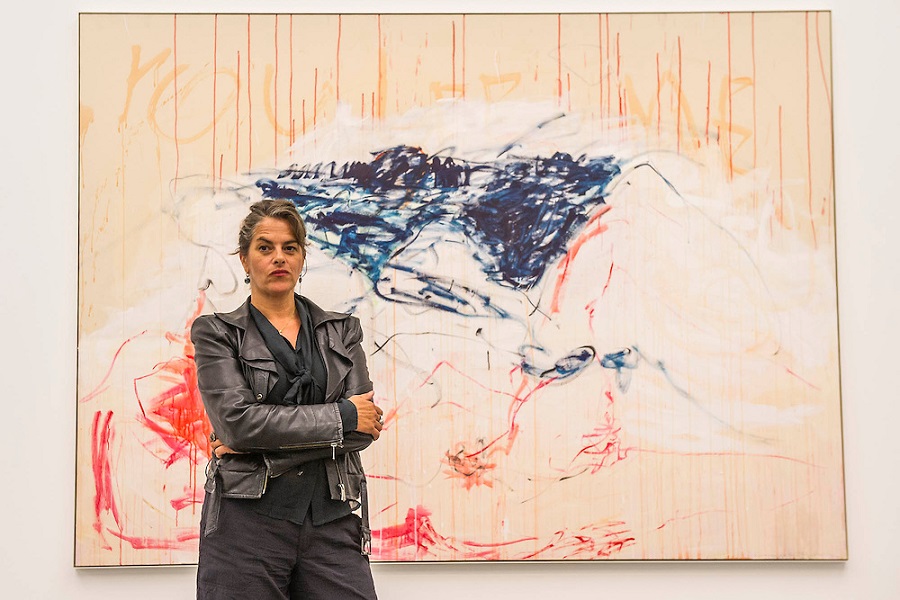
"The last great adventure is you" (Image available at gbphotos.photoshelter.com)
During the 80's, Emin studied fine art at London's Royal College of Art, a period from which very little work remains as she herself destroyed it. It was here that she became part of the so-called Young British Artists (YBAs), alongside Damien Hirst, Mark Ofili, Sarah Lucas, Marcus Harvey and the Chapman brothers, who began exhibiting at the start of the 90's with Charles Saatchi as their patron, a gallery owner and advertising executive with a keen eye for promotion and cultural marketing.
The recurring nature of Emin's excesses became the narrative of her work in those early days of celebrity: drawings, photography, patchwork, videos, installations ... Her entire output reflected the impact of her memories, as in the early performance piece at a Stockholm gallery: Exorcism of the last painting I ever made (1996). Here, fully naked, she painted walls and pictures with autobiographical themes, and thereby unlocked a longterm emotional blockage - that of her two abortions - whilst at the same time and from a clearly feminist standpoint, criticising so-called “women’s work” by the flaunting of her own flesh, sexuality and corporality.
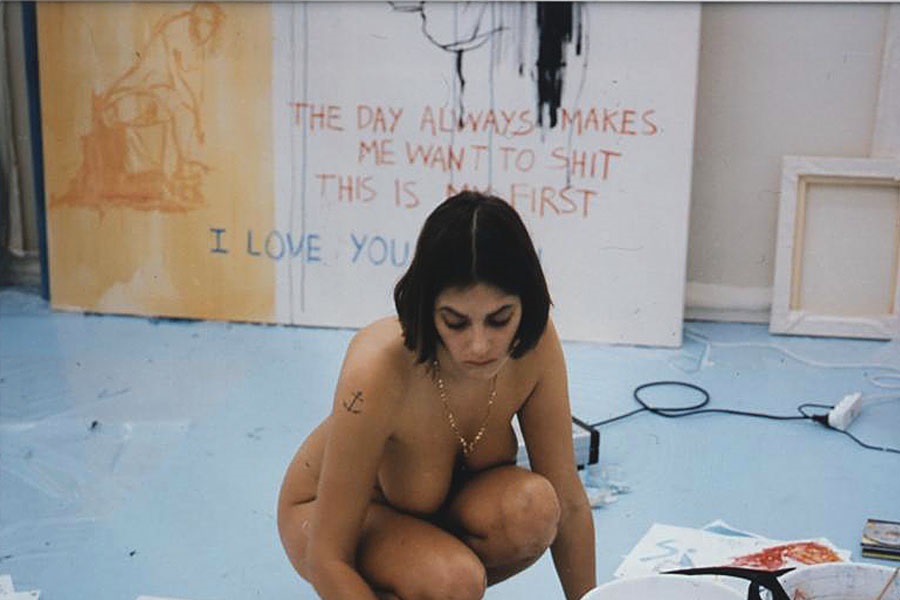
"Exorcism of the last painting I ever made" (Image available at www.dazeddigital.com)
Of course, the seminal symbol of those excesses was My bed (1998), the work that got her shortlisted for the Turner Prize and is arguably her best known piece and the most controversial one of her career. The fact that it was bought at auction in 2014 for £2,200,000 by a German collector only confirms the ironic transformative power of our perception concerning the most provocative of art. To paraphrase the well-known proverb, 'sometimes when you don't make your bed, you don't have to lie in it'. Because it's on loan to and on permanent exhibition at the Tate Gallery in London!

"My bed" (Image available at www.huckmagazine.com)
The piece consists of her own unmade bed, the sheets stained with bodily fluids and the surrounding floor littered with rubbish such as condoms, empty cigarette packets, bottles of alcohol, newspaper cuttings, knickers soiled with menstrual blood and other assorted domestic debris. The sexual promiscuity along with the alcohol and drug abuse, that played a major part in Emin's life at that point, made the devastatingly intimate scene a spectacle and a display of her confessional art, to which the viewer became an involuntary voyeur. My bed could be considered, although not without a certain provocation, an organic self-portrait by the artist, an exploration of herself from a place of collapse and emotional crisis. Pure, unadulterated reference-to-self. Or, in her own words: “the absolute disaster and decadence of my life”.

"My bed" (Photograpy by Niklas Halle'n)
In the same vein is Everyone I Have Ever Slept With 1963-95, a tent adorned with their names, including sexual partners, relatives she shared a bed with in childhood, her twin brother and her two terminated pregnancies. The crude depiction of those memories is then not only a written roll-call of her lovers and loved-ones, in a kind of womb-bedroom, it's also defending, and this as a powerful message, the role reversal implicit in a more self-conscious and aggressive female sexuality, a woman who "womanizes". Perhaps it was this feeling of discomfiture that made a visiting journalist exclaim: “But she's even slept with the curator!"
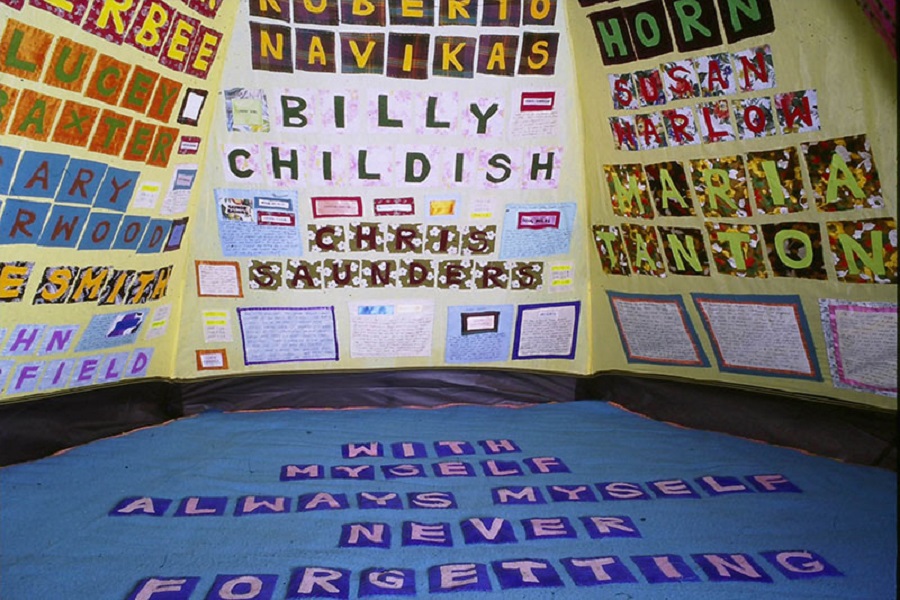
"Everyone I Have Ever Slept With 1963-95" (Image available at www.christies.com)
The evolution of Emin's work has also been characterised by a transition towards other fields of experimentation. The early photography and painting exhibitions, for instance the delicate watercolours of Berlin The Last Week in April 1998, the performances and installations of her most wild-child time, when she even dared to appear drunk on primetime television, started to show, from 2000 onwards, her artistic debt to Schiele. Immortalised in the sinuous limbs and exposed vulvas of The Purple Virgins, shown at the 2007 Biennial, a clear line can be traced back to him which continued in later erotic-leaning works such as the Suffer Love series (2009). It was, therefore, not at all surprising when in 2007 she was awarded the chair of Professor of Drawing at the prestigious Royal Academy of Arts, where she has also curated some summer exhibitions.

"Suffer Love I" (Photography by Stephen White/EFE)
Artistic recognition and critical acclaim have gone hand in hand with huge media interest in her public sculpture and montages. While it's true that she had already explored the genre before, her own face in Death Masks (2002) for instance, it was now that her sculptures had their full impact. When she designed a mast for outside Liverpool Cathedral, 4 meters high, bronze-plated, crowned with an emblematic Liver Bird in hommage to the city, she sealed an alliance not only with the BBC, who had commissioned it, but also, in a way, with the English establishment itself.
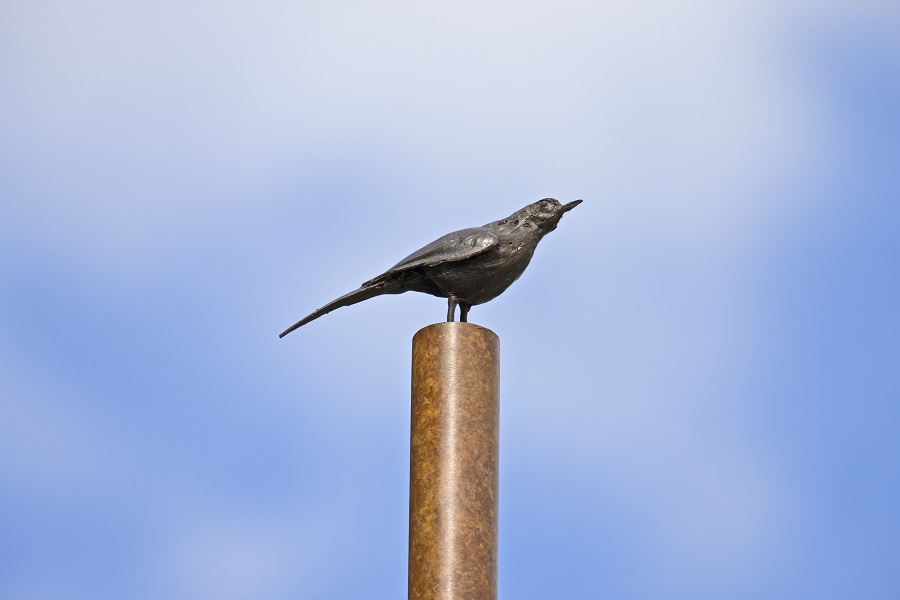
"Liver Bird" (Image available at www.traceyeminstudio.com)
When, a few years later, she returned to install one of her neon messages above the cathedral's main doors, she only ratified that position. Neon, traditionally a publicity tool of language to attract our attention and sell us something, manages to break free from that association through the intimate nature of its content: I Felt You And I Knew You Loved Me. Few times, if ever, has a church been quite so daring.

"I felt you and I knew you loved me" (Image available at mathi.eu)
In any case, bronze as well as wood have played a major role over the last decade. From It's not the way I want to die (2005) and Tower (2007), through the delicate sculptures (shoes, teddy bears, children's socks) scattered throughout Kent in 2008 and of undeniable social import, up to the most recent The Last Great Adventure is You (2014), to name but a few.
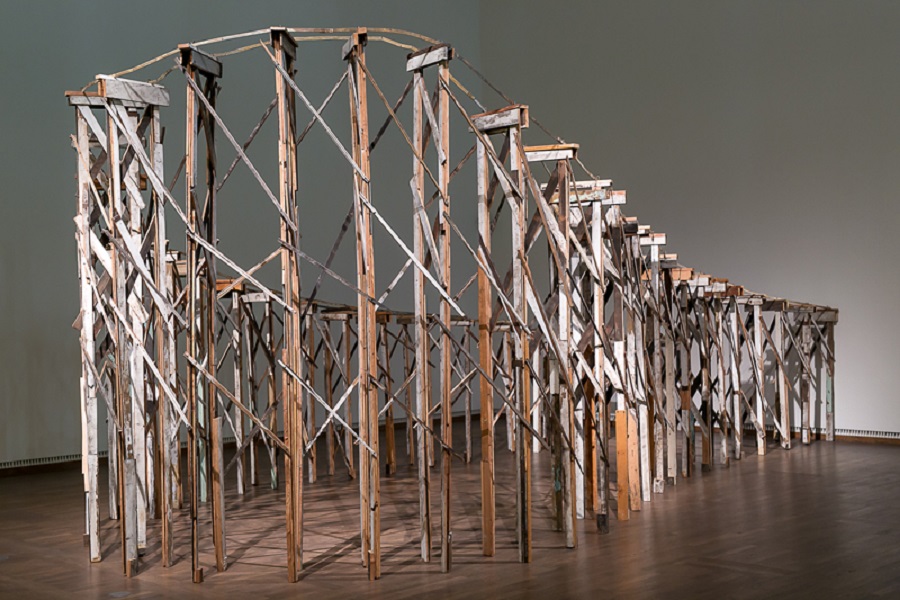
"It's not the way I want to die" (Image available at www.traceyeminstudio.com)
The validity of Emin's work remains undeniable, the theory she produces considerable. Remember that it was Emin and her radical feminist consciousness who, before the "selfie" era and the social media explosion, was first to expose such intimacy and vulnerable sexuality. She gave visibility to loneliness, sentimental failure and the alienation of success. Emin is an enfant terrible who made it into the Hall Of Fame of the most acclaimed (millionaire) artists of today, much to the detriment of British political correctness.
(Translated from the Spanish by Shauna Devlin)

"Welcome Always" (2008)

Tracey Emin at the CAC in Malaga (Photography by Jesús Dominguez /EFE)
Tracey Emin: What do artists do all day (in English)
- Zaha Hadid. Biografía, Obras y Exposiciones - - Página principal: Alejandra de Argos -
- Details
- Written by Elena Cué
Launched to fame by the Italian Trans-avantgarde in the early 1980s, the work of Francesco Clemente (Naples, 1952) follows an undetermined, enigmatic style that is in constant transformation and flow. The turning point that marked his career was his mystical journey to India in the 1970s, where he found spiritual reconciliation. Clemente had the wise intuition to settle in New York, where he has developed the core of his work. Much of Clemente’s pictorial production is figurative, through portraits whose ghostly atmosphere reveals a transcendental vision. It is this fusion of cultural roots where East meets West that gives him his most personal touch. From his studio in New York we will be exploring his life and his work.
Author: Elena Cué
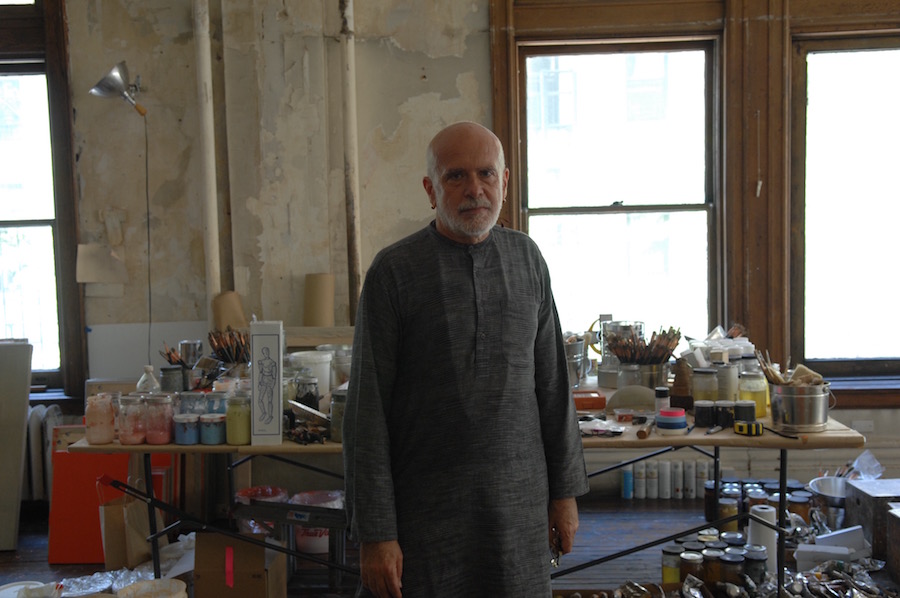
Launched to fame by the Italian Trans-avantgarde in the early 1980s, the work of Francesco Clemente (Naples, 1952) follows an undetermined, enigmatic style that is in constant transformation and flow. The turning point that marked his career was his mystical journey to India in the 1970s, where he found spiritual reconciliation. Clemente had the wise intuition to settle in New York, where he has developed the core of his work. Much of Clemente’s pictorial production is figurative, through portraits whose ghostly atmosphere reveals a transcendental vision. It is this fusion of cultural roots where East meets West that gives him his most personal touch.
From his studio in New York we will be exploring his life and his work.
I would like to start asking you about your youthfulness. What was your experience in Italy, bearing in mind all the political unrest at the start of your career, with the terrorism with the Red Brigades, the social conflict…?
If you say 60s, we are talking about my teen years and what comes to mind is boredom. I’m very lucky, because I lived at a time when you could be immensely bored. I think that without boredom, you can’t get any new ideas in your head. From that, we entered the 70s. Yes, my generation is the last Marxist generation. Also, the seventies was the last decade that produced ideas, and some of those ideas are still valuable to me. I’m a big fan of Debord’s book, The Society of the Spectacle. There is a flag here in the studio that shows a quote from the book, which is a prophetic book.
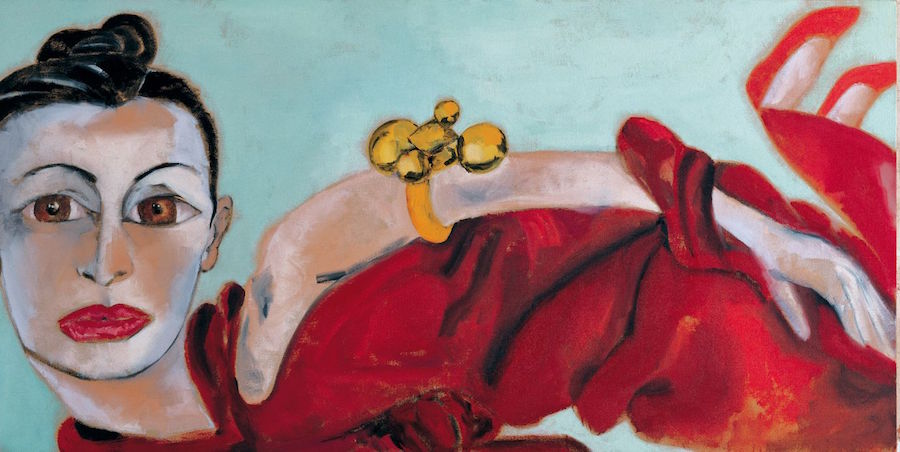
“Alba,” Francesco Clemente. Photo: Guggenheim Bilbao
And then, in the 70s you travelled with Boetti to Afghanistan and then to India….
I travelled to remote parts of Afghanistan with Boetti. We went all the way to Pamir, the crossroad between Pakistan, China and Russia. It’s the very tip of Afghanistan. It was an adventurous thing to do, but back then you could do that.
And you opened a studio in Madras. What were you searching for in India?
I felt that history had led me to a dead end. I didn’t see where I could go. So I decided that my work should draw from geography, rather than history. I didn’t know anything about India when I went there the first time.
What has interested you most of Hindu culture: the more sensual aspect with its chromatics, the corporeal aspect… or do you prefer the spiritual side?
That’s a Western dilemma: spirit against body. But even in the West, in the alchemic tradition, they say you should spiritualize matter and materialize spirit. So I was looking for reconciliation.
You have also worked with Hindu artists, and I have seen you continue work with them. What do you get out of the joint creation process?
Well, I believe that the most accurate description of our consciousness is continuity of discontinuity. So I indicate with my work the fact that we have a fragmented self and I’m interested in the gaps that separate all our different personas. Many of these ideas can be found in the contemporary traditions of the East. All of those traditions deal with this.
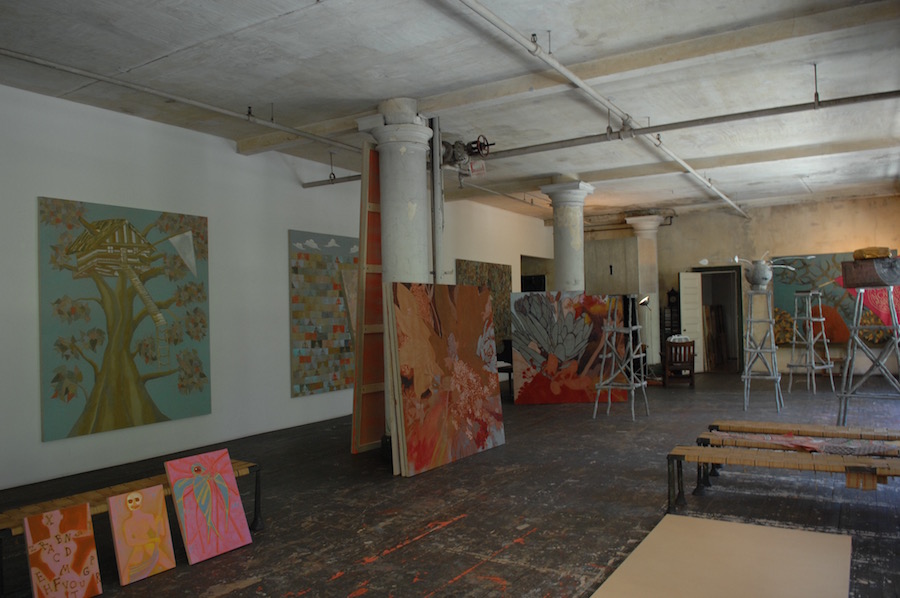
Estudio de Francisco Clemente en Nueva York. Foto: Elena Cué
You were one of the main figures of the transavantgarde movement of the 1980s, when painting was upheld once again as a reaction to immaterial avant-garde. How do you remember this change?
Well I think those few years were a window of liberty and adventure, which didn’t last very long. Today, we are confronted with an international style that is in a way very neutral and very academic, if you want. So again, I was very lucky to be in the right place at the right time.
What led you to subsequently split from this movement?
It wasn’t really a movement. I think, actually, that whole generation of artists lacked a proper theoretical background and no one really bothered with that. So there were a few labels, you know, the neo-expressionist, the transavantgarde… but all of these were only labels. It was more of a synchronicity of several people in different parts of the world going back to making art drawn from life and not from other art.
When you look at the paintings of that time, at the explosion of feelings and expression of desire, dreams and fantasy, do you recognise yourself?
I’m an empty chair... I don’t have a self to recognise.
What can you tell me about your collaboration with Basquiat and Warhol, two of the most representative artists of the New York scene of the 80s?
I think the reasons of the work are more important than the appearance of the work, so I’m very proud that we did these collaborations because they show that the intentions are stronger than the appearance. I mean on the surface, these three works are very different from one another, but somehow they are drawn together by all the things we didn’t like, rather than what we liked. I have fond memories because I personally liked both artists tremendously. I was very close to both of them. I miss them both. They could both be alive… it is still their time.
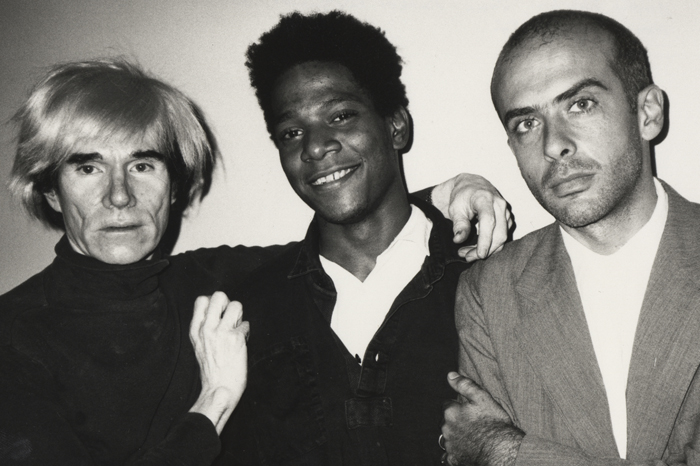
Andy Warhol, Jean-Michel Basquiat & Francesco Clemente photographed by Beth Phillips, 1984.
Is art enough to meet your spiritual need?
No, I pray every day. Art is a form of giving, not a form of receiving. You don’t receive from art… you give to art. But to give is also a need.
Which have been your main obsessions?
My obsessions are constantly renewing themselves. I move from one obsession to the next. But in my trade, obsession is not considered a disorder; it’s considered a necessity.
Most of your portraits are impenetrable. What do your faces speak of?
Eternal life, maybe.
And are you also impenetrable?
I’ve been told three times by very different people that I remind them of smoke. Is smoke impenetrable? I don’t know. Hard to catch, for sure.
There have been many changes throughout your artistic career, as well as in your techniques. What is the reason for so much movement, so much change?
It was my intention from the beginning to not anchor myself to a particular solution, or a particular style. At the same time, that is my strength because it means that everything I do is fresh, and my weakness because I am constantly beginning, which means that I never know what I am doing. Also, the goal of my work is to remind the viewer of the necessity to be fluid, to be in a constant state of transformation.
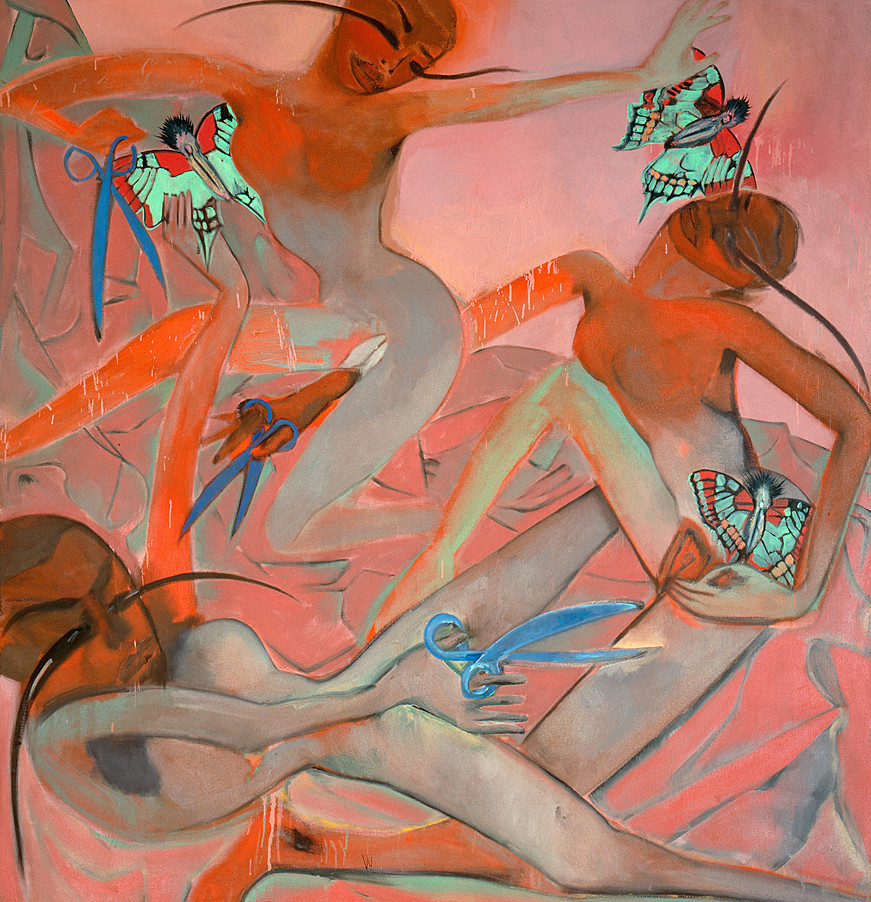
“Scissors and Butterflies,” Francesco Clemente. Photo: Guggenheim Bilbao
Your paintings are very enigmatic. What do they mean to you?
My paintings are enigmatic, life is enigmatic. Everything is an enigma, everything is a mystery. There’s a beautiful quote in a de Chirico painting that says in Latin: Et quid amabo nisi quod aenigma est? (And what shall I love, if not the enigma?)
Do you discover something about yourself during the process of making your paintings?
The advantage of making something by hand is that you never make what you intend to make, so then you have to adapt to the circumstances. So in that sense, you have to be open all the time, and upset, which is a good lesson for life.
Do you recognise the state that you were in at the time of painting?
Yes, my paintings are tied to the changes in my life and they’re tied to a sense of synchronicity. I’m a believer in synchronicity. You know, the simplest example of synchronicity is when you think of someone and then you turn the corner and you see that person. I am very much in touch with that kind of resonance and symmetry in life, where things don’t happen on their own, they happen in clusters. They all bounce against each other. I’m a listener… I listen to the harmony of life and I translate that in my paintings.
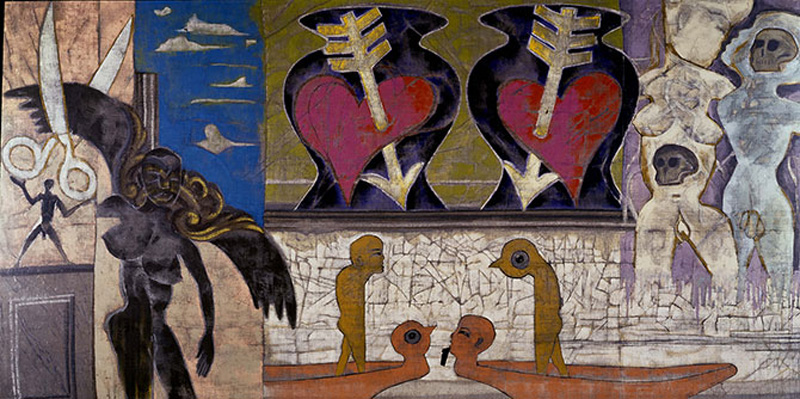
“Iniziazione, La Stanza della Madre / Initiation, Mother’s Room,” Francesco Clemente. Photo: Guggenheim Bilbao
Isn’t your painting a sonata of specters?
Yes, I definitely feel like a ghost a lot of the time. I wouldn’t want to feel too real.
You, who were born and trained in Italy, who has lived an intense experience in India and who now lives in New York, how do you relate with your identity? Who are you, from among these three strong identities?
The aim is to not be a prisoner of any of these identities. The space I really want to inhabit is the space in between all of these identities. From each place I want to remember and long for the other one. I don’t want to belong anywhere, really.
Do you need to find inspiration whilst travelling, or is it something you do not seek? Perhaps it is like Picasso said, that inspiration has to find you working?
One thing leads to another. The only obstacle in life is ourselves. If you remove yourself from the picture, there is really nothing you can do.
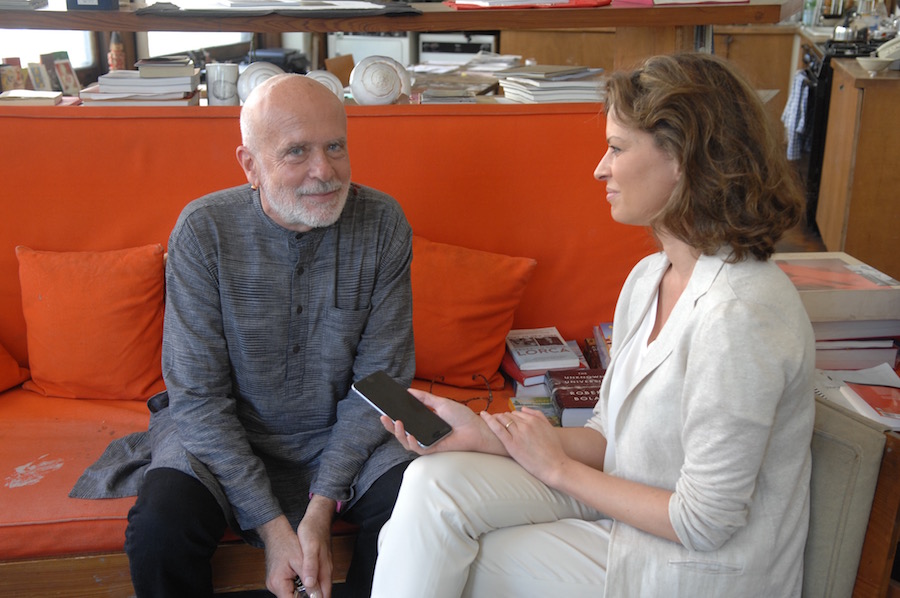
- Interview with Francesco Clemente - - Alejandra de Argos -
- Details
- Written by Marina Valcárcel
We are here for what could arguably be called the retrospective of an unknown artist. The Terzo Pilastro Foundation in Rome is showing the largest exhibition to date of a certain Banksy, the faceless star of Street Art. A pseudonym for a rebel artist whose incisive, sometimes ironic and irreverent work, questions and denounces the political and social mores of our time. A short distance away from the Cipolla Palace where the exhibition is being held, in another palace on the Vía del Corso, hangs Velázquez's "Portrait Of Pope Innocent X"; we can only imagine wryly his thoughts, more amazed than ever, watching the endless queues wind past the canvas: 15,000 entrance tickets sold in the first fortnight. What would Velázquez think of this graffiti artist who dared to depict a Christ similar to his own but whose outstretched hands, instead of being nailed to the cross, are holding aloft shopping bags stuffed full of gifts, sweets and champagne?
|
Author: Marina Valcárcel
Art Historian
|
 |
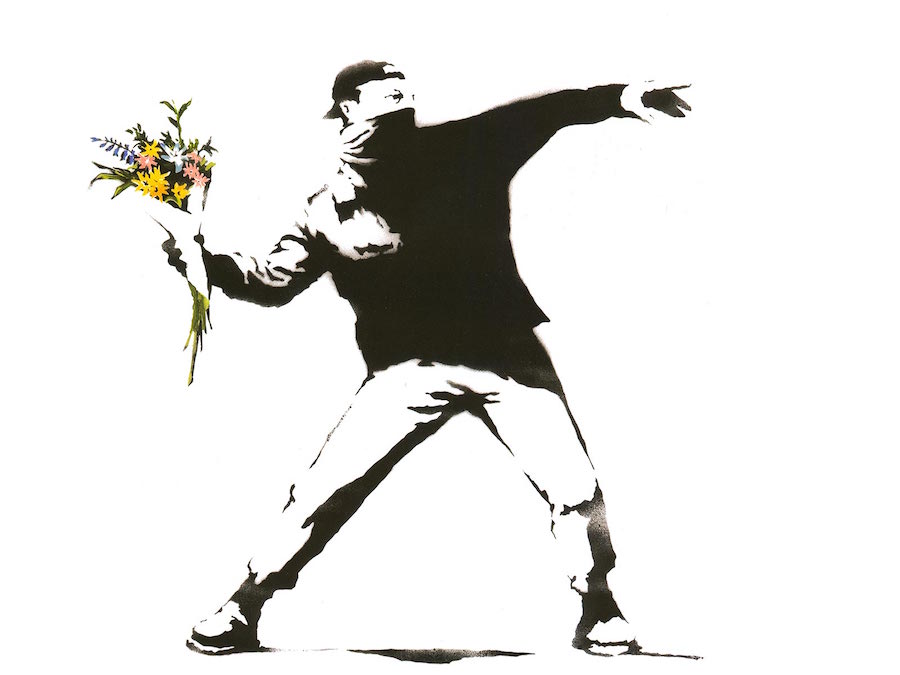
We are here for what could arguably be called the retrospective of an unknown artist. The Terzo Pilastro Foundation in Rome is showing the largest exhibition to date of a certain Banksy, the faceless star of Street Art. A pseudonym for a rebel artist whose incisive, sometimes ironic and irreverent work, questions and denounces the political and social mores of our time. A short distance away from the Cipolla Palace where the exhibition is being held, in another palace on the Vía del Corso, hangs Velázquez's "Portrait Of Pope Innocent X"; we can only imagine wryly his thoughts, more amazed than ever, watching the endless queues wind past the canvas: 15,000 entrance tickets sold in the first fortnight. What would Velázquez think of this graffiti artist who dared to depict a Christ similar to his own but whose outstretched hands, instead of being nailed to the cross, are holding aloft shopping bags stuffed full of gifts, sweets and champagne?
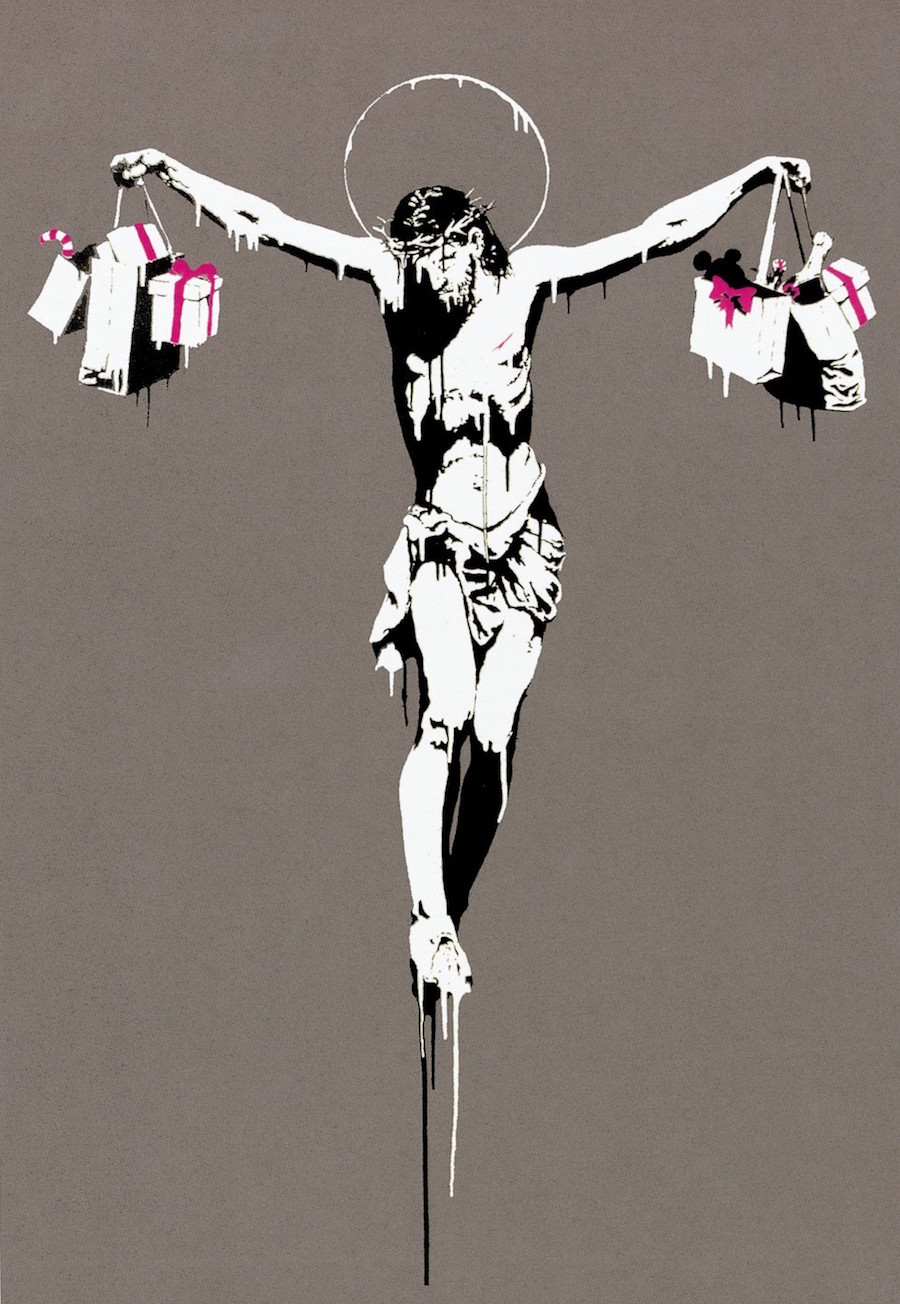
"War, Capitalism And Liberty" is the title of this exhibit that encapsulates three of the main concerns tackled in the discourse of this instigator of a brand new type of engagement, one that is more astute, more intelligent and double-edged, all essential qualities in today's world. His anti-materialist, anti-capitalist and anti-establishment skits have spread like wildfire, particularly amongst the young. Banksy is not just a graffiti artist but a thinker. His campaign of action, far-reaching and sustained, would be on a par with the best Secret Service strategies. Between 1992 and1994 his work, but not he, was to be found in each and every one of the places his audience looked for him.
First gallery, first wow factor: in the same way that his "Love Is In The Air" (Flower Thrower), that emotive graffiti picture of a 21st century "Discobulus of Myron", in which a young boy in full flight, his face hidden under a handkerchief and baseball cap on backwards, throws what one would expect to be a molotov cocktail but is, in fact, a bunch of flowers ….. the exhibition kicks off with a similar punch. It's a message from Banksy that could just as well be a gas canister: or a petrol bomb: "I like to think that I have sufficient courage to reclaim, anonymously, in a Western democracy, the things that nobody believes in anymore ~ peace, justice and liberty." And after this quote, highlighted against a jet black background, come 150 of his works, dated 1998 to 2011 and all belonging to private collections, spread over ten rooms. The curators have pointed out, in no uncertain terms, that Banksy had absolutely no involvement in the organising of this exhibition.
According to popular myth, Banksy, born in Bristol, perhaps in 1974, would be around 40 and recently married to a Labour MP. He is, therefore, a good 8 or 10 years younger than those other two revolutionaries on the British art scene: Damien Hirst and Tracey Emin. His anonymity is arguably the key to his success. But there's a big question raised by this exhibition, already asked and unanswered since his 2009 Bristol show. Will Banksy move from being the guy who painted on inner-city street walls in provincial UK cities, to being a painter of canvasses that hang in grand European museums or in galleries frequented by the likes of Tom Cruise, Cristina Aguilera and Angelina Jolie, all willing to pay hundreds of thousands of dollars for them? Arcoris Andipa, a curator of the exhibition and the Greek gallery owner settled in London who has sold more of Banksy's work than anyone else, claims: "His success lies in the intelligence of the messages in his work."
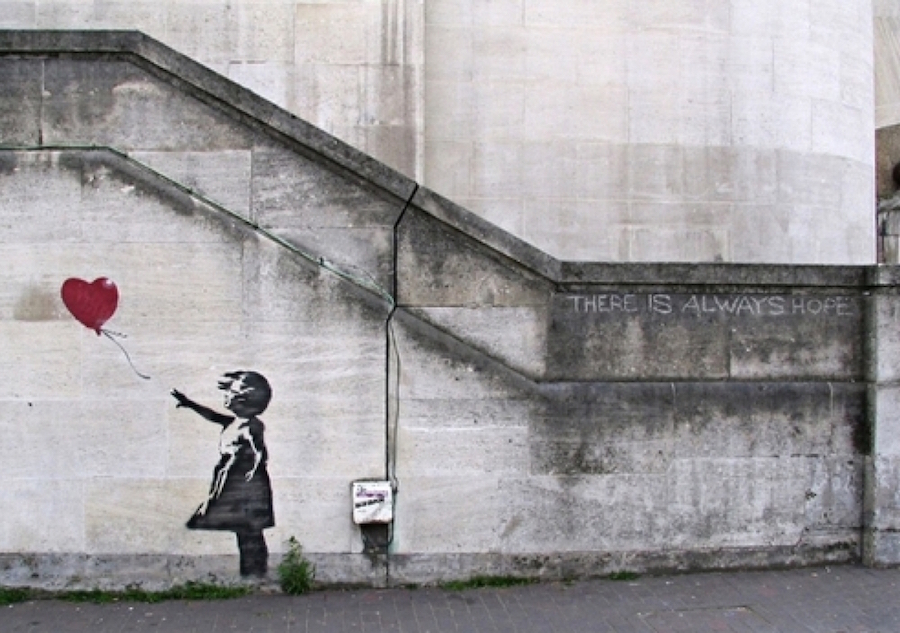
Perhaps before Banksy there was little possibility of graffiti being accepted as art. Even so, in today's world, the limitation lines are blurred. One could wonder at the dearth of books on the subject of Urban Art compared with the proliferation of images, usually without any accompanying text, posted on artists' websites and social media. For this reason, let's look briefly at the two tendencies in Street Art: graffiti and post-graffiti. Graffiti, first seen in Philadelphia in 1959, is a popular tradition throughout the Western world whereby street gangs mark out their territory and achieve fame by spraying or writing their names or other slogans on walls or any available surface throughout the city with aerosol paints and felt-tip pens. In 1970's New York, this extended to railway carriages in the subway. Keith Haring describes it thus: "I arrived in New York at a time when the most beautiful paintings on display in the city were on train wheels. Paintings that travelled to you rather than the other way round."
Postgraffiti, on the other hand, to which artists from Basquiat to Banksy belonged and started in New York in the 1980's, is graffic and very rarely textual. They are images that seek to engage passers-by in a dialogue between artist and spectator, a sort of intimate connection in a public space. They invite us to participate, to marvel on every street corner or wall at the message left, the critique drawn, the authorship signed. They want us to recognise their style and become fans of it. They want to leave their footprint. Postgraffiti emerged from the confluence of academic art, principally pop, and various forms of urban culture, namely graffiti proper, punk rock and skate. It could be defined as a self-promotion campaign with no financial gain to be had and in which the artist has total freedom. Graffiti artists fit a very narrow profile: always young, always men, the majority of them design or fine art students who substitute stencils, stickers or free-hand painting for aerosol sprays. Their uniform is the 'hoodie' - to hide their identities - and trainers, to get away quickly. They all grew up in the internet age and this is their means and method of injecting their art into the veins of the world.
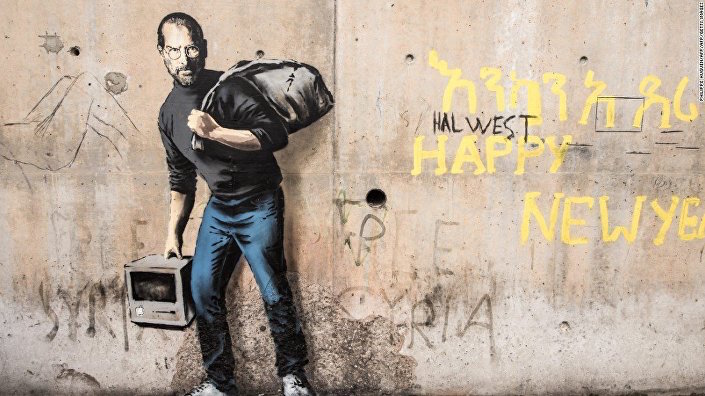
Every piece of art looks strangely out of place if we remove it from the place it was originally destined for. We are in the city of Caravaggio and contemplating his "Calling Of St Matthew" which does not look the same, up close in the gentle light of the Contarelli Chapel, as it would on a cold museum wall. And it's notable that this effect is multiplied exponentially with Banksy. In the Cipolla Palace, his pictures and lithographs lack the force that a portion of wall "borrowed" from the street would afford them. They have little in common with the emotional response to the little girl trying to fly out of the Gaza Strip on a fistful of balloons or the late Steve Jobs painted as a Syrian immigrant in Calais. Part of the charm of urban art is its transitory nature, the feeling that its lifespan is dictated by vandals or the police. So here, neatly ordered and reproduced in series, the magic of its fragility, its creation in the night-time, in the light of a streetlamp and the instability of a stroll are all but lost. This was the internal debate Banksy pushed us to. Graffiti is a form of guerrilla warfare. It's a way of stealing power, territory and glory from a more heavily-armed enemy. Banksy once called it "a form of revenge". All of this is lost beneath the protective domes of a palace in Rome.
It is estimated that there are more than 140 places around the world where Banksy carried out his work. This exhibition allows us a unique journey: to unravel some of the enigma of Banksy without having to trek all the way from Israel to New Orleans.
War, Capitalism And Liberty
Terzo Pilastro Foundation, Cipolla Palace, Vía del Corso 320, Rome
Curators: Stefano Antonelli, Francesca Mezzano and Arcoris Andipa Until 4 September 2016
See also:
(Translated from the Spanish by Shauna Devlin)
- Banksy: From the Backstreets to a Roman Palace - - Alejandra de Argos -
- Details
- Written by Clelia
Banksy is the pseudonym of the most high-profile graffiti painter in contemporary Street Art. Although there are no concrete biographical facts to go by, it is believed he was born in the outskirts of Bristol in 1974, later moving into the city where he spent his adolescence. A recent study by Queen Mary University in London identified the artist as Robin Gunningham and confirmed he grew up in Bristol. According to the illustrator and graphic designer Tristan Manco, one of the most ardent researchers into urban art, the controversial Banksy was an apprentice butcher before getting into graffiti during the 80's "aerosol boom". In the 90's, he was a gang member of Bristol’s DryBreadZ crew, aka DBZ, at which time his fame began to spread like wildfire, mainly due to his tit-for-tat overpainting war with the top graffiti artist of the day, King Robbo.
Banksy is the pseudonym of the most high-profile graffiti painter in contemporary Street Art. Although there are no concrete biographical facts to go by, it is believed he was born in the outskirts of Bristol in 1974, later moving into the city where he spent his adolescence. A recent study by Queen Mary University in London identified the artist as Robin Gunningham and confirmed he grew up in Bristol.
According to the illustrator and graphic designer Tristan Manco, one of the most ardent researchers into urban art, the controversial Banksy was an apprentice butcher before getting into graffiti during the 80's "aerosol boom". In the 90's, he was a gang member of Bristol’s DryBreadZ crew, aka DBZ, at which time his fame began to spread like wildfire, mainly due to his tit-for-tat overpainting war with the top graffiti artist of the day, King Robbo, whose work along Regent's Canal in Camden Banksy took the liberty of "revamping" repeatedly until, on learning of the late Robbo's comatose condition, he put an end to their feud and paid his rival a series of heartfelt tributes.
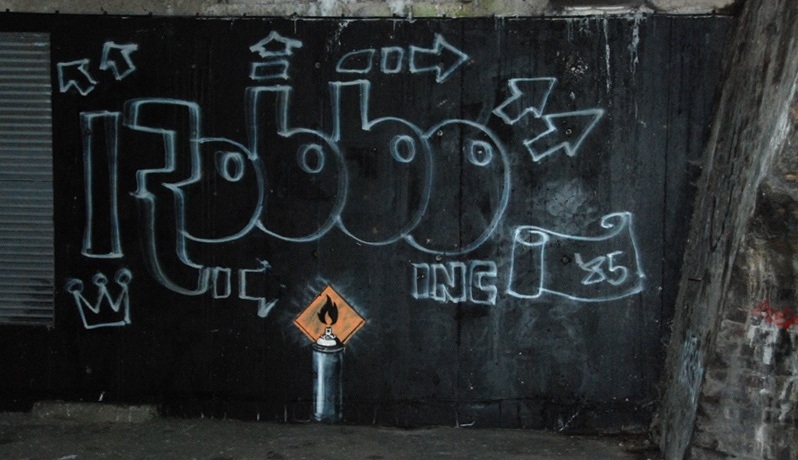
Robbo inc, availible at streetartlondon.co.uk
On the 12th of July 2008, the Mail on Sunday announced it had discovered his real identity, revealing his name as Robin Gunningham, which the actual Mr Gunningham has always denied when questioned. According to other sources, his real name might be Robert Banks or Robin Banks although the latter would appear to be a play on the words "robbing banks".
Whatever the case may be, mystery still surrounds him. According to Will Simpson, secretary of the Bristol Easton Cowboys and Cowgirls football club, the artist accompanied them on a 2001 tour of Mexico in which he played matches against the Zapatista Liberty Fighters. There exist photographs of him painting a wall mural in honour of their cause, his pixelated face well-hidden under a handkerchief and no other discernible clues to his identity whatsoever. Those photos were published in the book 'Freedom Through Football: The Story Of The Easton Cowboys & Cowgirls'.
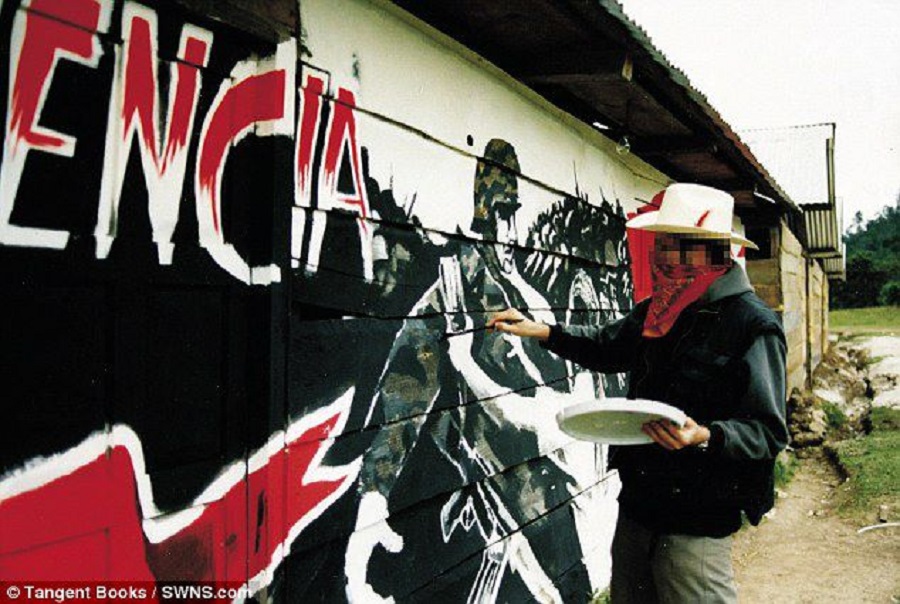
Banksy painting a mural in Mexico, availible at www.12ozprophet.com
In his book 'Wall And Street', Banksy remembers his early days as a street artist spraying the paint directly onto the wall. This technique required time, however, which posed a risk as graffiti was neither art nor legal at that time. He, therefore, began handcutting and using cardboard stencils and carspray to speed up the process and which had the added bonus of making his murals look far more 'accomplished'.
The term 'Street Art' encompasses all forms of artistic expression whose setting is outdoors, urban and, ostensibly, illegal. At the start, these paintings or texts left on walls, buildings and train carriages were given the name graffiti. Their origins can be traced back to the Afro-American and Latino ghettos of 60's New York as a reaction to the conditions and oppression they were living in. The earliest graffiti artists shared cultural tastes in music, dance and fashion and it was here that hip-hop was born. Later on, more artistic techniques came to be used, namely stencilling, wheat-pasted poster art, templates, installations, sculpture and sticker art.
The messages implicit therein were invariably politically or socially critical, as are Banksy's: "A wall is a very large weapon. It's one of the most unpleasant things you can hit someone with."
Few images illustrate this idea better than his "Maid In London" mural where a uniformed maid sweeps rubbish behind a wall as if to say: what we don't want to see, we hide from view.
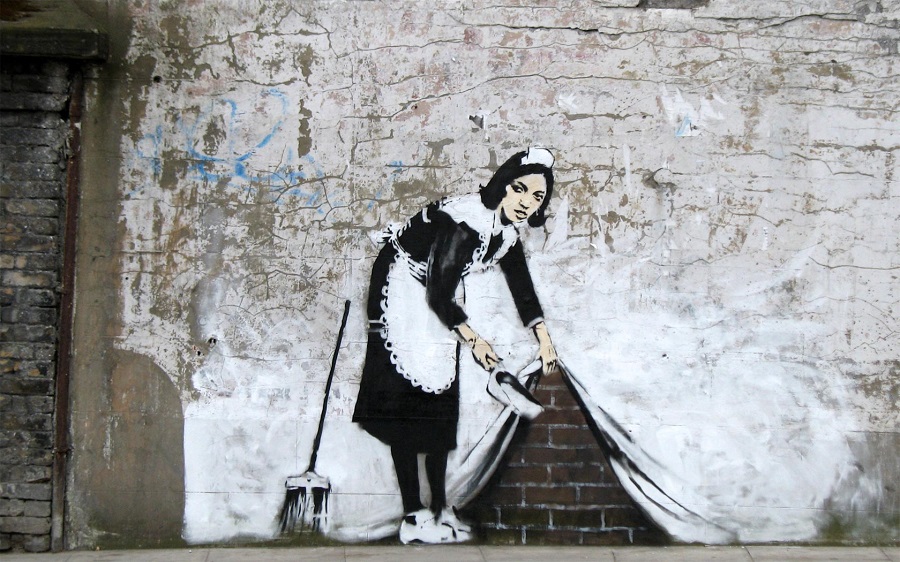
Maid in London, availible at academics.skidmore.edu
Banksy began by painting rats all over the streets of Bristol which served as his instrument of ridicule against 'The System'. Influenced by, among others, the punk band Crass and the Ad Jammers movement which focused on deforming and transforming publicity images and thereby their message, Banksy's work has always sought out a social or moral criticism, in the guise of irony or satire, in the form of writing, stencilling or graffiti.
But if anyone was ever Banksy's inspiration or influence, it was Blek le Rat, a prolific Parisian graffiti artist of the early 80's. It was from him that he copied the stencil and aerosol technique as a means of expressing his criticisms and complaints: "Every time I think I've painted something vaguely original, I find out Blek already did it, better, 20 years earlier."
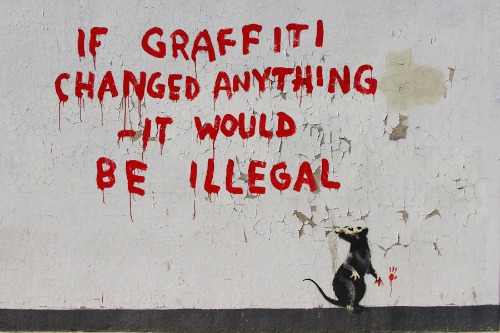
If graffiti changed anything – It would be illegal, availible at news.fitzrovia.org.uk
After those initial rat-taking-photos-of-passers-by or rat-listening-to-music graffitis came more work that continued to criticise social hypocrisies, only now they were also appearing on postboxes, doorways and drains. His 1988 "Naked" can still be seen on the façade of Park Street Clinic and it's not alone: a whole series of creations decorated first Bristol and then London, well-known examples being the two policemen kissing, the MonaLisa with bazuka rifle or the fleeing natives chased by a supermarket trolley.
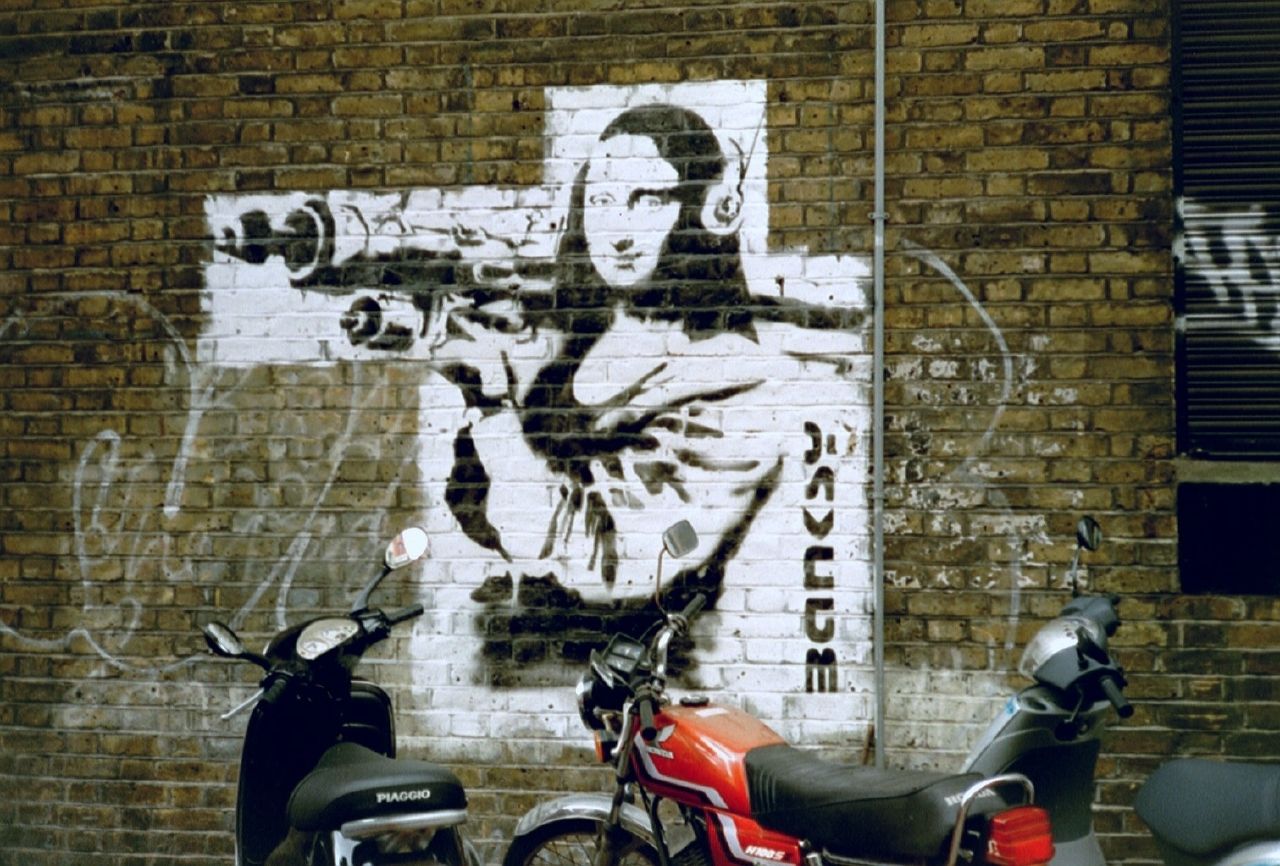
Mona Lisa With Bazooka Rocket, availible at nohaycomolodeuno.blogspot.com.es
By then, he was already collaborating with an agent, Steve Lazarides, a former photographer who had documented Banksy's first teenage forays into graffiti art and with whom he shared the running of his website where both of them added photographs of each and every new creation and thanks to which there is still a record of those that have since been erased, demolished or painted over. Lazarides confesses to having helped organise the infamous stunts which involved infiltrating the world's most famous museums and dislaying Banksy art clandestinely, as happened at London's Natural History Museum with a dissected rat pinned inside a frame. And that was not all. In the British Museum, for instance, they managed to hang an apparent landscape painting that on closer inspection revealed a hunt scene with a supermarket trolley. New York’s MOMA unwittingly displayed his portrait of a lady in period costume wearing a gasmask. "Art will be neither beauty nor novelty. It will be effective and it will be troubling," according to the artist.
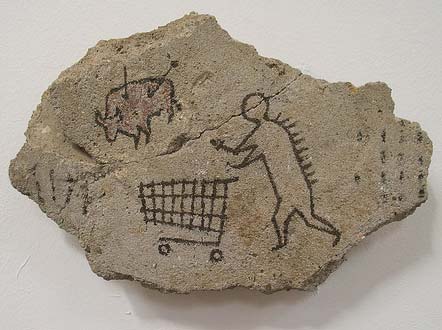
His work reached another level after being installed surreptitiously and viewed in four New York museums (the Metropolitan, Brooklyn, Natural History and Modern Art) and also when his street art started being seen across the world in other large cities like Melbourne and París. Come the year 2000, he decided to organise a solo exhibition and did so on the Severnshed, a floating restaurant, thereby distinguishing himself from all other street artists. Then, in 2003, came another exhibition, this time in London while later, in 2005 and 2007, two of the most important and striking creations of his career ~ the Gaza and West Bank murals.
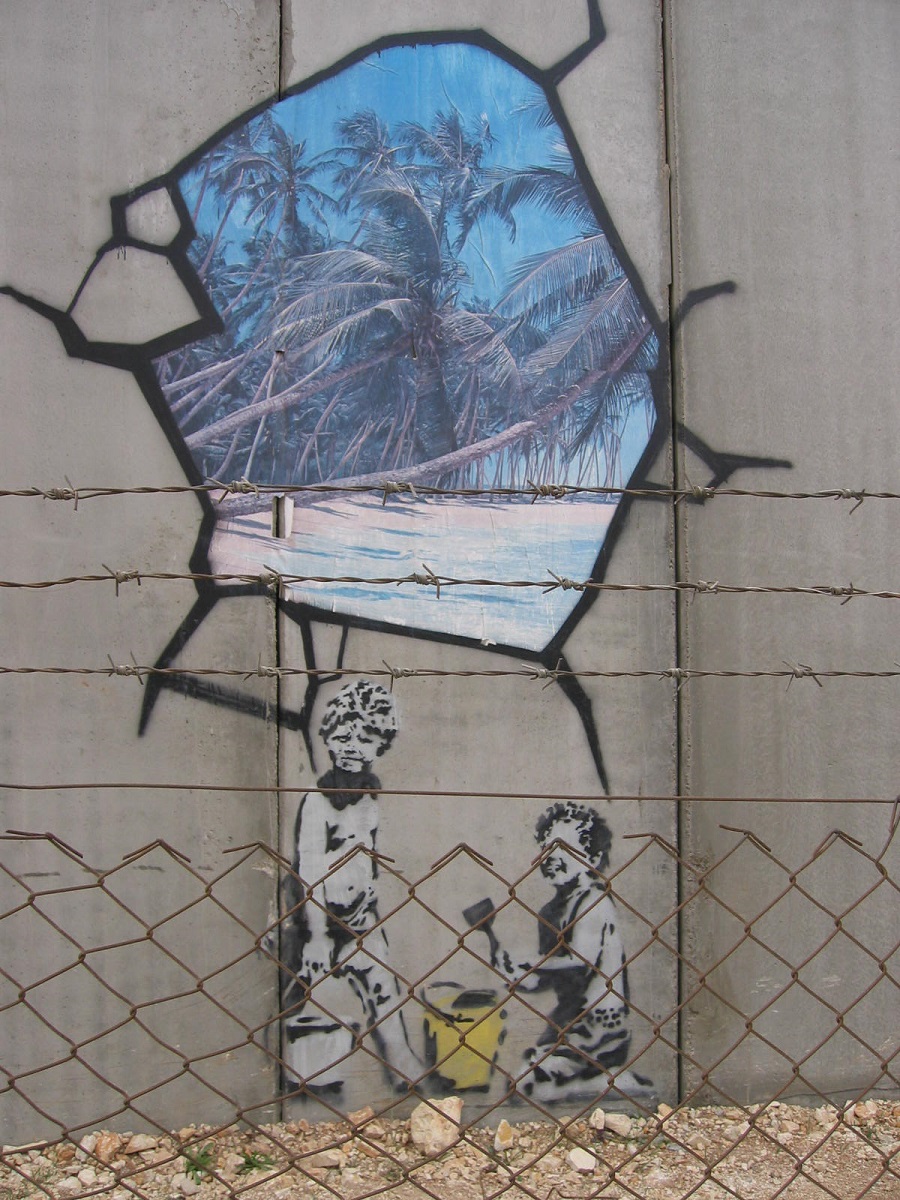
Banksy, availible at prospectornow.com
Banksy, who considered it "the world's largest open-air prison", covered the 'Wall Of Shame' on the West Bank with al fresco paintings that spelled out his opposition. Pictures of little girls clutching balloons in an attempt to escape, glimpses of blue sky and idyllic landscapes seen through holes and cracks are a cry for attention against its construction and existence. The repercussions were such that, even today, there is an alternative sightseeing tour to visit them.
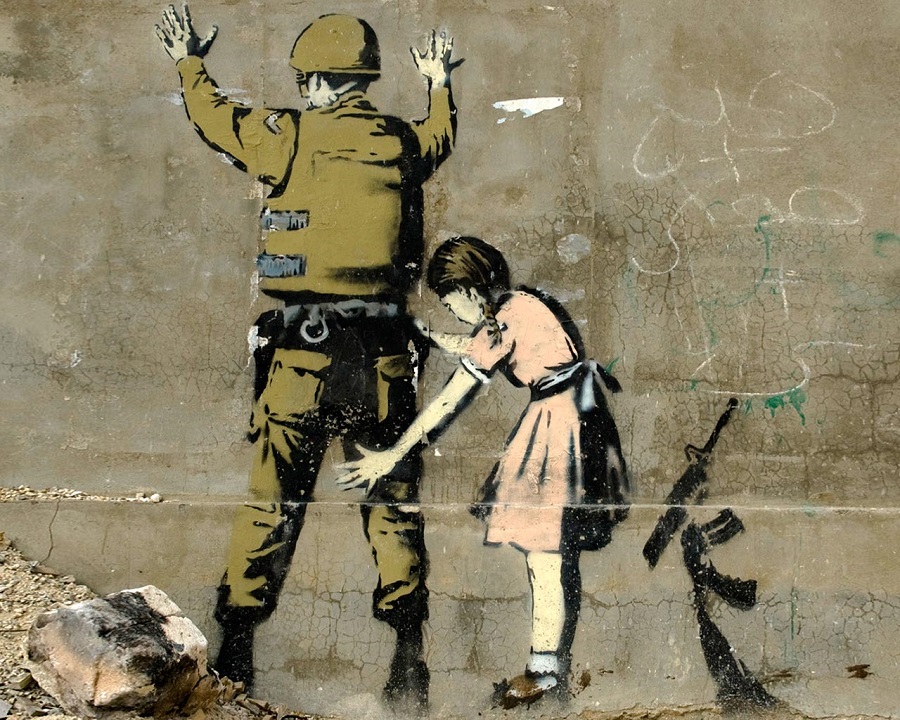
Girl and Soldier by Banksy, availible at http://www.stencilrevolution.com/
By this point, Banksy's works could be found all over the world, everywhere from Los Angeles to Barcelona. Amongst them, imitations of Miguelangelo's "David" wearing a bullet-proof vest and Van Gogh's "Sunflowers", completely withered. In 2006 he painted an emaciated, malnourished black child wearing that crown associated with a very well-known fast-food chain.
One successful show that stands out is his 'Banksy Versus Bristol Museum' in 2009 which involved closing the building to the public for three days while secret, large-scale preparations were made. The irony of this all being financed by those who had previously censored him was not lost on Banksy who remarked: "This is the first exhibition I've ever held where the donors' money has been used to display my work rather than erase it."
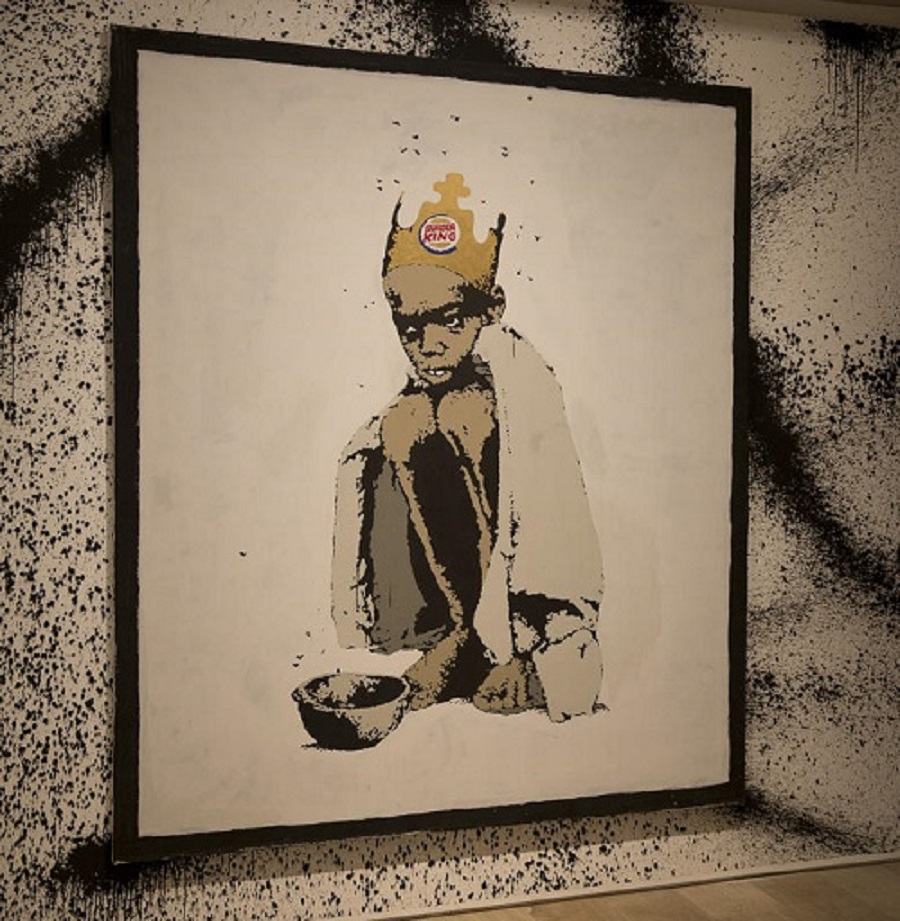
Availible at www.plataformadeartecontemporaneo.com
One of the main bones of contention between his followers and detractors is the extortionate price paid for some of his work. For such an anti-establishment and stern critic of capitalism, it seems to some rather ironic that his works are amongst the most expensive on the market. For this reason, some street artists accuse him of having "sold out" to the powers that be. Banksy, who once said that "Commercial success is a disaster for graffiti artists", saw his set of portraits of Kate Moss in the style of Warhol's "Marilyn Monroe" sell for $80,000 at Sothesby's in 2006. And then again in April 2007, his "Space Girl & Bird" (spray paint on steel) sold for half a million dollars. A few months later, Bonham's sold ten of his works for a total of half a million pounds sterling (€700,000). And the bids show no sign of stopping there. Nevertheless, in 2013, Banksy decided to open a pop-up street stall near Central Park selling original, signed canvasses for $60 each. Oddly, only eight of them were ever bought.
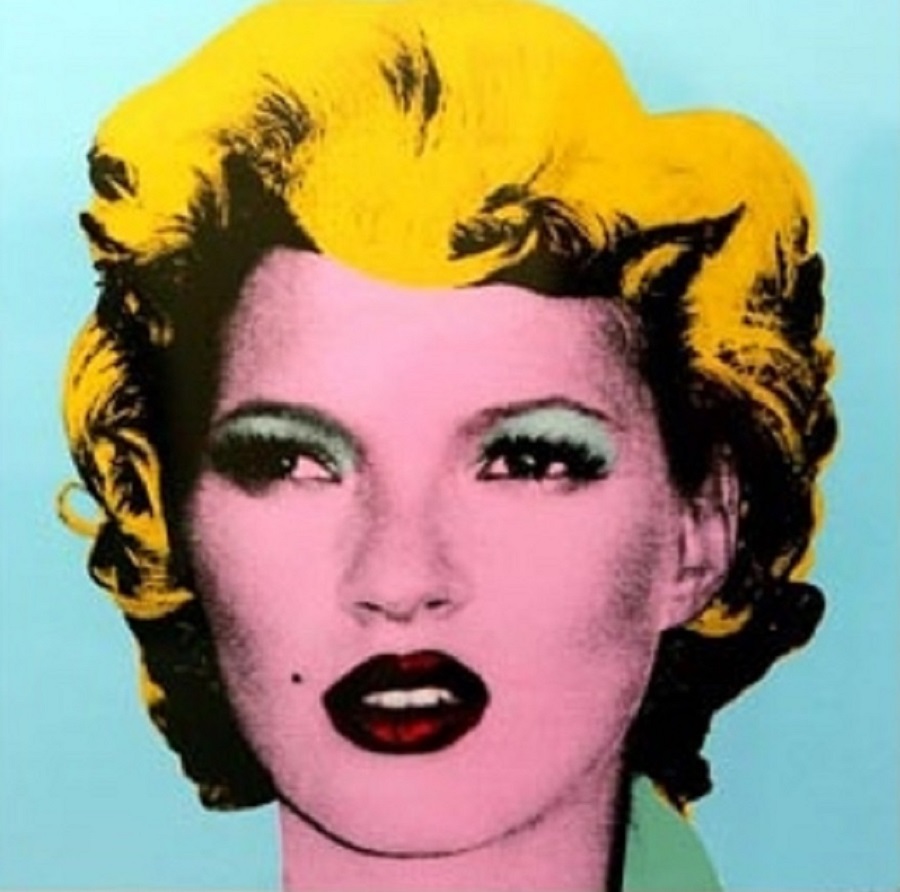
Kate Moss, availible at www.banksy-prints.com
During his New York tour that same year, Banksy carried out an illegal exhibition called "Better Out Than In" whereby he created a different artwork every day somewhere on the city streets. He tweeted: "Looking forward to getting my hands dirty tonight!" And he most certainly did, using graffiti, sculpture and even video to get his characteristically sarcastic humour across.
Never far from controversy, there are many who have denigrated his work: some calling it vandalism; others pure hypocrisy for criticising capitalism whilst working for large corporations like Puma and MTV. For others, take for example Gareth Williams, head of Urban Art at Bonham's in London: "The most incredible thing about the Banksy phenomenon is not his meteoric rise, nor the high prices collectors pay, but the fact that the very establishment he satirises has welcomed him with open arms."
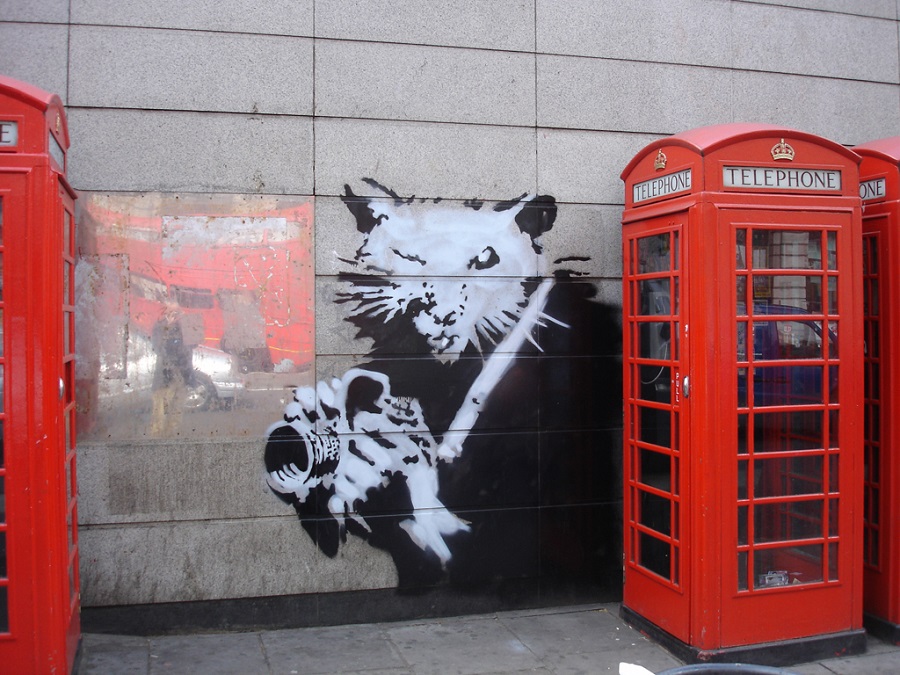
Rat Photographer,availible at www.whatsonyourwall.com
And so to the controversy surrounding his 2010 documentary entitled "Exit Through The Gift Shop". Many were hoping for all to be revealed about their mysterious artist but hoping was as far as they got. The documentary was nominated for an Oscar, as well as an Independent Spirit Award and a BAFTA, and got excellent newspaper reviews in the Los Angeles Times and the Chicago Sun Times to name but two. In it, Banksy introduces us to Thierry Guetta, a French man living in Los Angeles, whose unique obsession is filming the artist on video. The two meet and Banksy decides to turn the camera instead on Guetta, persuading him to infiltrate the Urban Art world with the alias Mr. Brainwash and turning him into a celebrity in his own right.
Clips from "Exit Through The Gift Shop" (Thierry, Banksy: Can marketing create an artist?)
And this is where the controversy took off. Is what the documentary says about Mr. Brainwash fact or fiction? Is he an actor or for real? For many, it was just an elaborate montage of Banksy's to show what has become of street art, namely just another consumer product, an investment opportunity seized upon by the upper classes and Thierry Guetta or Mr. Brainwash was nothing other than the alter-ego of Banksy himself. And to thicken the plot further, the artist Ron English confirmed that Thierry Guetta was totally real and that Banksy himself had explained in conversation his motives for making the film ~ to ridicule Guetta for his egoism in refusing to share hundreds of hours worth of filming the artist in action.
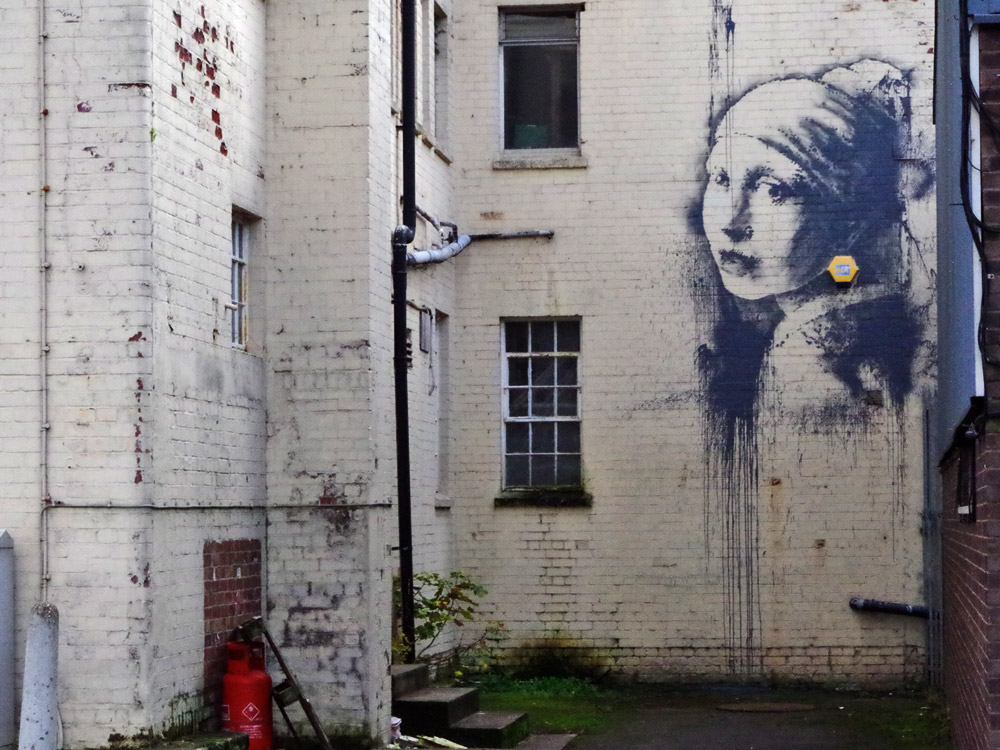
Girl with a pierced Eardrum found at Banksy.co.uk
In October 2014, Banksy created a new graffiti 'portrait' of "Girl With A Pierced Eardrum", a parody of Vermeer's" Girl with a Pearl Earring" in which he exchanged the jewel for a security alarm on the front wall of a recording studio in Hanover Place, Bristol. The work got a lot of media attention, especially because it was done back in the artist’s hometown and shortly after the rumours of his alleged arrest started to circulate. 24 hours later, however, the work was ruined by black paint in a clear act of vandalism and antagonism towards its author. And nor was this the first, last or only time Banksy's work would be damaged: his "Art Buff" in Kent, for one instance, was vandalised with a crude penis. Due to the prominence he has achieved over the last few years, however, some of his public artworks are now protected behind sheets of clear perspex, allowing them to be protected or restored more easily.
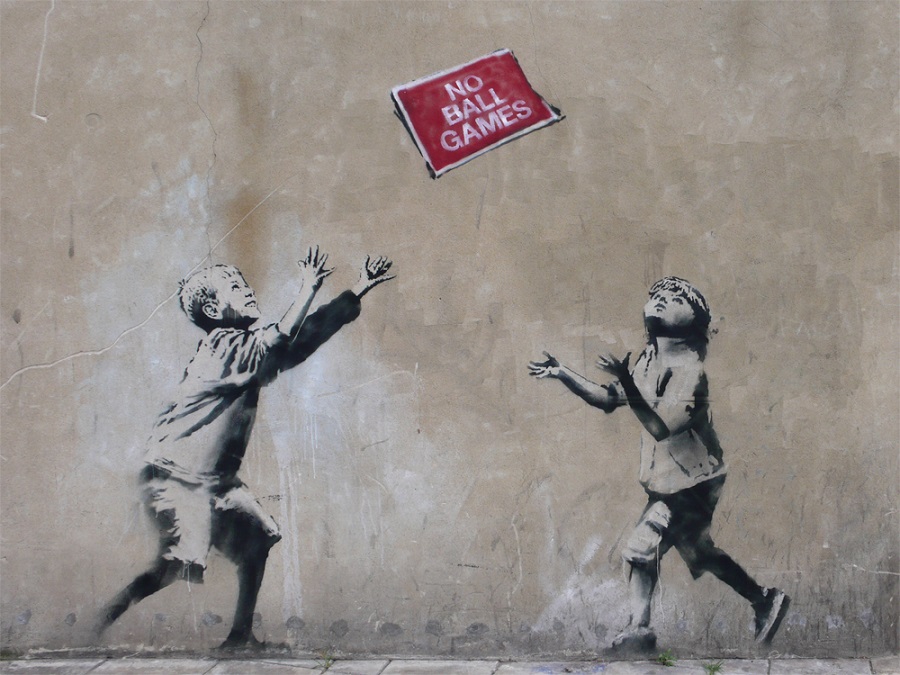
One of Banksy's murals before being cut into 3 pieces and moved to an exhibition. Found at banksy.co.uk
One of the most recent exhibitions on the artist, set up by The Sincura Group under the title "The Stealing Banksy", took place in London in 2014, exhibiting 7 street artworks that were then to be auctioned afterwards. Not for the first time, Banksy vociferously rejected the whole project despite the organisers assuring him of the building owners' consent. He is quoted as calling it "simply disgusting that anyone can take art off walls without permission."
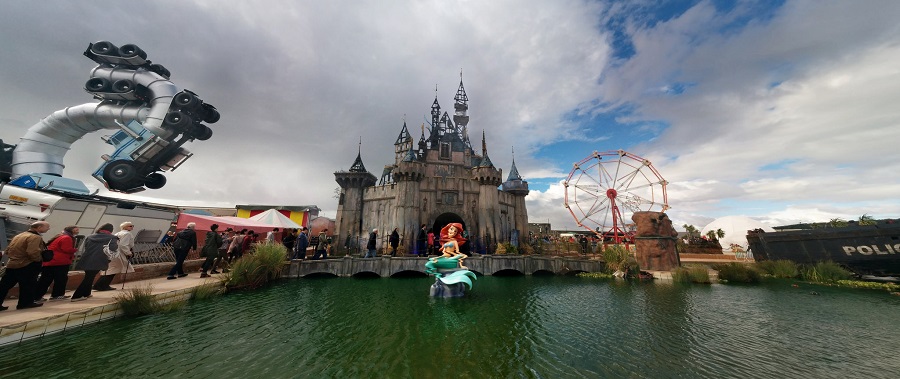
Banksy's Dismaland. Published in Flickr by Peter Gasston
In August 2015, Banksy inaugurated the temporary, theme-park-styled installation "Dismaland" in collaboration with 58 other artists. When this closed its doors, the construction team moved what they dismantled to a refugee camp in Calais and built various housing units and a playground funfair for refugee families. After the recent, forced evacuation of the camp, the official Dismaland website (http://www.dismaland.co.uk/) says simply: "Dismaland Calais has now closed".
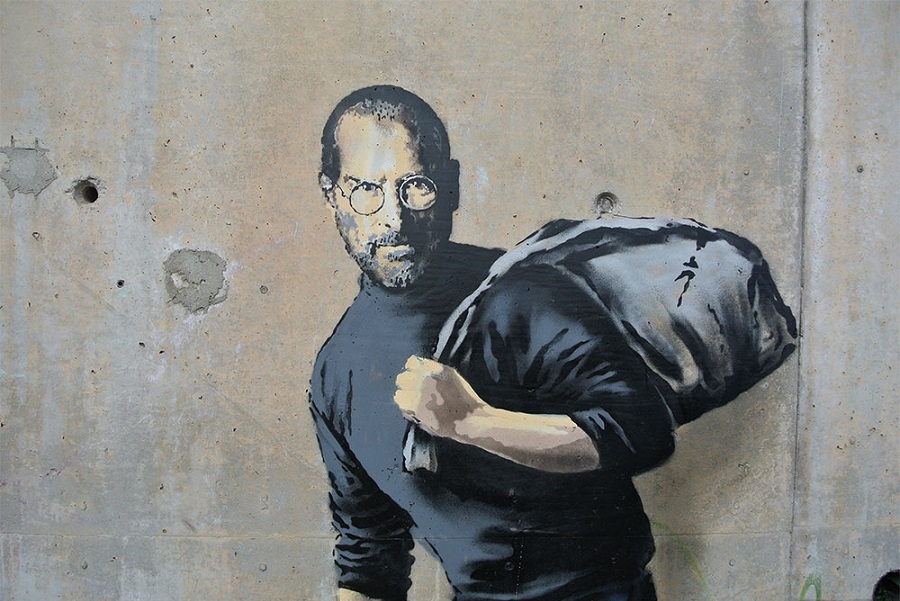
Son Of A Syrian Immigrant. Found at Banksy.co.uk
That December, a new Banksy painting entitled "The Son of a Syrian Immigrant" appeared on a camp wall, picturing the late billionaire Apple founder Steve Jobs with a bag of belongings slung over his shoulder. It is a clear attack on the conditions endured by Syrian migrants in the infamous "Jungle” camp at the French port.
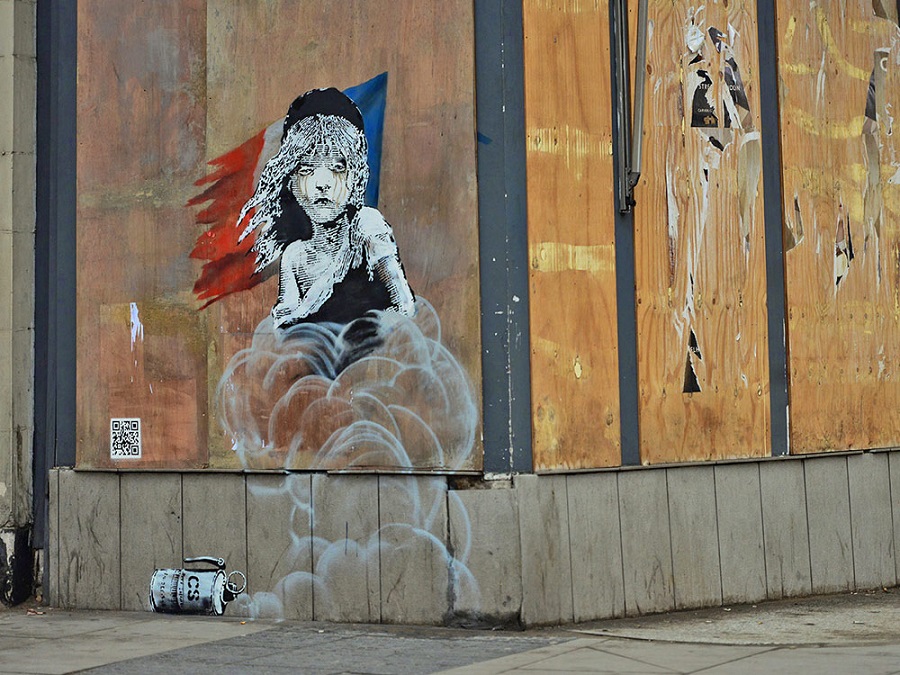
Found at banksy.co.uk
His criticism of the situation continued into January of this year when his first interactive artwork appeared. On a wooden board placed outside the French Embassy in Knightsbridge, he painted Cosette, the little girl from the "Les Misérables" poster, with a ripped French flag behind her, tears rolling down her cheeks and a billowing canister of teargas below. A scannable QR code at the bottom of the picture links to a Youtube video showing police firing teargas whilst raiding the camp in Calais, on 5th January 2016. Photos of the picture went viral and 42 hours later, thieves attempted to steal it which meant the Metropolitan police were forced to intervene and safeguard it.
In February, the portion of wall in question was completely covered over by Cheval Property Management Limited who own the land the building stands on. They confirmed this as a temporary measure, however, until such time as the "future plans for the work are decided".
From 13th January til 29th February 2016, Banksy's works were on show for the first time in Istambul in the exhibition "The Art of Banksy" with the patronage of the Turkish Ministry of Culture. The exhibition, coinciding with the inauguration of the Global Karaköy gallery, took a group of 80 experts almost a year to set up, taking it upon themselves to track down, requisition and catalogue the artist's last 15 years of work. "Banksy has done a huge amount of artwork, the majority of which has never been seen by many people. I've managed to get hold of it thanks to collectors who made a massive effort to reveal the pieces and their whereabouts," said Steve Lazarides, the exhibition's curator, who also confirmed it as the most extensive ever undertaken of the work of the elusive Banksy.
Visitors to the exhibition were able to enjoy it in singular fashion as it included detailed replicas of both the streets of London and Banksy's studio workshop, allowing them to access more closely and experience more vividly the context of the graffiti's creation and the poetic, critical and humorous energy of this mysterious and much-talked-about artist.
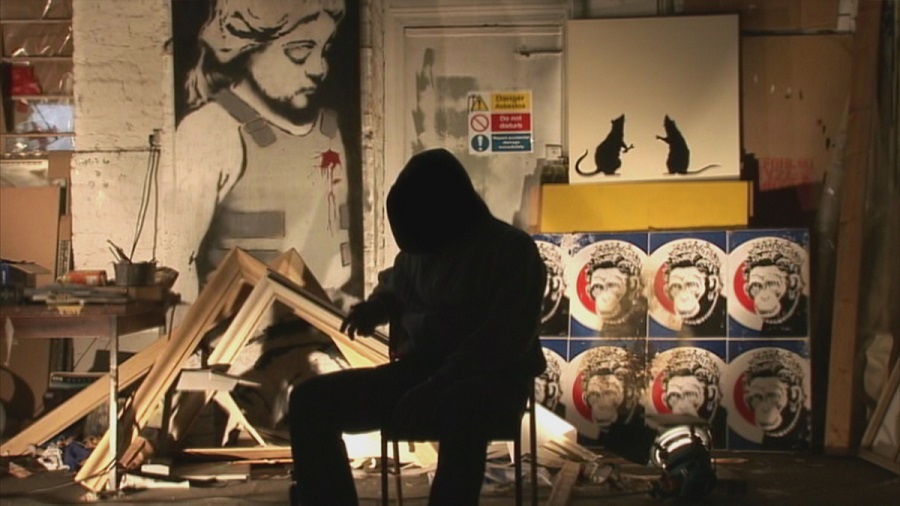
The artist in his studio
Whatever might or might not be going on around him, it's undeniable that Banksy is the most sought-after, controversial and admired artist in his field. He doesn't need publicity, nor does he seek approval because his creations speak for themselves and provoke reflection in those who view them. Too many of his pictures have disappeared, like, for instance, nearly all of those to do with the 2012 London Olympics. People have tried to thwart him by ruining his work, destroying and damaging it or stealing it to sell on at exhorbitant prices. Many others, however, find his work and words inspiring, aspire to follow in his footsteps and imitate his unmistakable style.
Banksy vs Bristol Museum
Picture Gallery: Banksy - Works, click on the photos to see them full sized
https://www.alejandradeargos.com/index.php/en/all-articles?start=77#sigProGalleria6c503b98d4
(Translated from the Spanish by Shauna Devlin)
- Banksy: Biography, Works and Exhibitions - - Alejandra de Argos -

